Most reliable "best" radio
-
Judging from the "power enhanced" title in this listing: https://www.amazon.com/dp/B082VLQK1M?psc=1&ref=ppx_yo2ov_dt_b_product_details
I'm guessing that they are probably si24R1's, even though the chip labeling in the photo says that they're nRF24L01's. I ordered some, and with the aid of the PPK2, I'll know soon just what they are.On Aliexpress they're even cheaper, but the wait is much, much longer: https://www.aliexpress.com/item/2251801699158809.html?spm=a2g0o.cart.0.0.202b38dax6gRtv&mp=1
They're so inexpensive that for short-range maybe they're good enough. I'm sure once the chip shortage is over that atmega328p's will be back to around $1 each. A $2 transceiver is pretty amazing. Like you say, the golden age.
-
@NeverDie said in Most reliable "best" radio:
On Aliexpress they're even cheaper, but the wait is much, much longer: https://www.aliexpress.com/item/2251801699158809.html?spm=a2g0o.cart.0.0.202b38dax6gRtv&mp=1
At 10 for $5.30, I can wait. I just ordered some!
-
@Larson What good luck: looks as though the pinout is an exact match for the pinout on my nRF24L01 adapter board for the test platform:

Makes me wonder what those two through-holes are for near the antenna?

Looks as though they are meant for something. Anybody know what those two through-holes are for?
-
Ignoring the warning about not transmitting for longer than 4ms at a time, I'm presently trying to blast out a continuous stream of packets from the nRF24L01 at 2mbps datarate without pausing between packets. According to the datasheet, one way to do it would be to start sending the first packet while ensuring that the Tx FIFO never empties. However, none of the libraries seem configured for doing that, so it involves working with the nRF24L01 at a lower level. In the worst case, I guess I could settle for a 4ms long packet train if that's the best it can do, but maybe an nRF24L01 equipped with a TCXO could perhaps go longer than 4ms? The 4ms is evidently a PLL limitation, and I'm not sure exactly how the PLL interacts with the crystal, or whether or not a better crystal will lengthen the continuous transmit time.
Anyone here tried this before? I mean, come on, a lot of people here use the nRF24L01 as their go-to transceiver. Anyone? Anyone? Bueller? Anyone?
-
@NeverDie It has an on-board frequency synthesiser so maybe during tx the temp rises on the substrate and this affects tx frequency stability? So it could be the FS rather than the PLL. Again just guessing here....
-
I went and did it. I got it to transmit continuously for many seconds before it peters out. And the packets it sends can be received, decoded, and understood. Exactly how long it goes seems to vary from one burst to the next, but a reset gets it going again. Anyhow, it works more than long enough for my purposes.

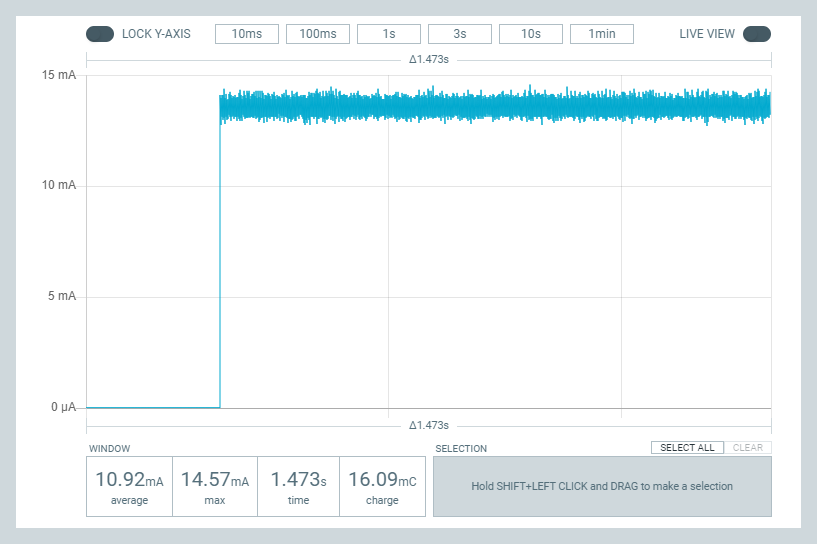
In case you're wondering why the current draw isn't higher (as it was in earlier pictures), it's because I turned the power all the way down to minimum, since I'm testing at close range.
-
Also, I'm happy to confirm that the amazon smd nRF24L01 modules that I ordered (see earlier post) have a pinout that matches my nRF24L01 adapters. I've tried it out, and it works:
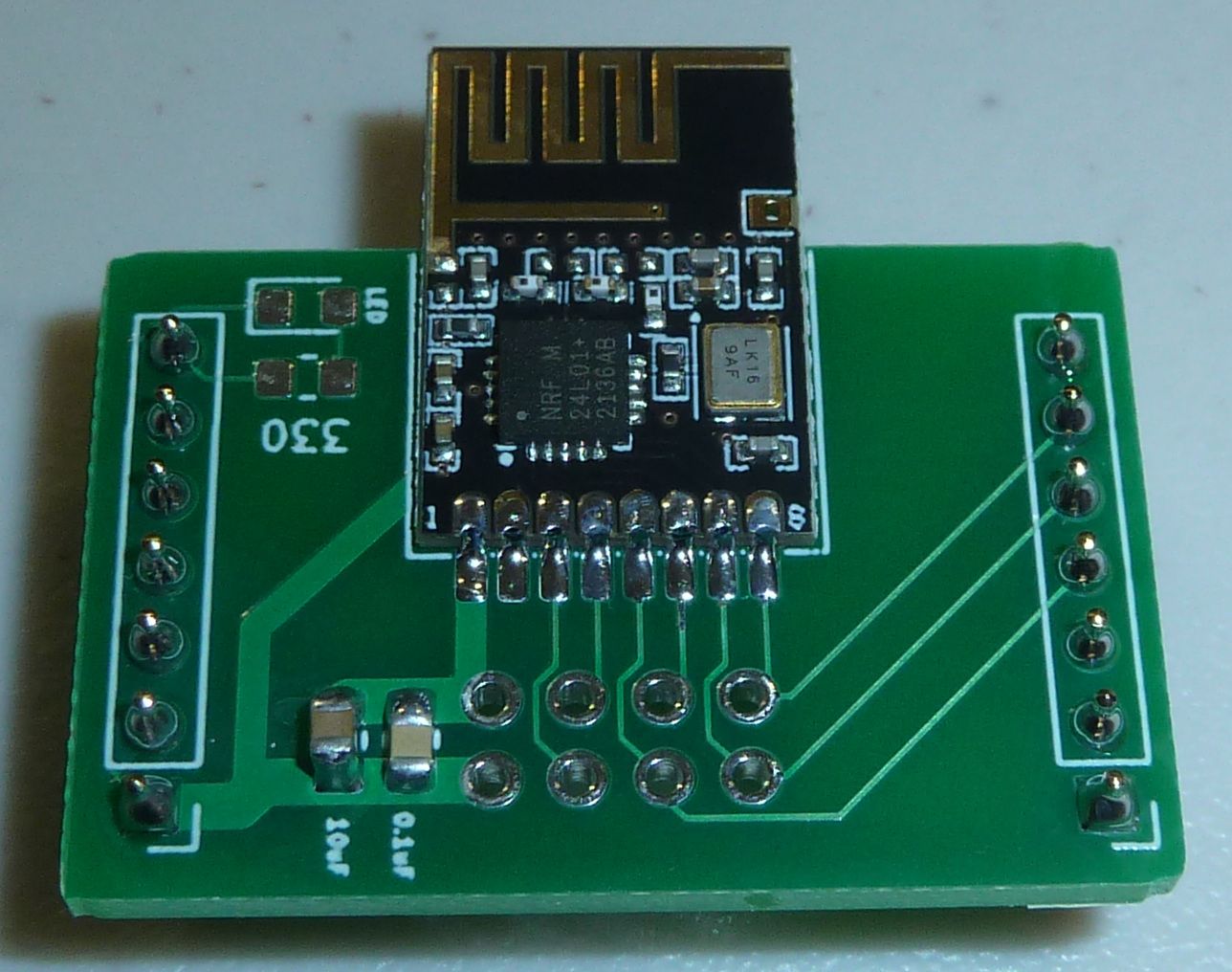
That said, what I received is a little bit different than what was pictured in the amazon listing. If you look at the through-holes that are near the antenna, one of them is much smaller on the modules that I received. It's much more like a via than a through-hole.
-
Lastly, it sounds as though the shortage of legacy chips is going to continue for quite some time:
Where The Real Chip Shortage Is – 11:53
— AsianometryThe TL;DR is that there's little profit in those chips, and so there's no motivation for manufacturers to build expensive new plants to pump out yesterday's technology. I posted recently about the attiny3226, and now I wish I had bought some, because they're now all out of stock everywhere. I'm therefore debating whether to buy some attiny3224's, which lack as many pins, because they're presently in stock but soon will be sold out, jut like the attiny3226's. It might be years before things get back to normal.
-
@NeverDie said in Most reliable "best" radio:
Makes me wonder what those two through-holes are for near the antenna?
On ESP8266's, I wondered if the PCB antenna could be cut with a dremel tool and be fitted with an equivalent whip-wire. It would be cheap enough to try. It looks to be that the NRF24's are maybe making that easier? Again, cheap enough to try.
Thanks for all the updates to https://www.openhardware.io/user/310/projects/NeverDie#view=projects I've been busy updating all the files I've collected. You have been hard at work. All the added *.png and *jpg pictures really help. The *.rar files make it really easy to get into the guts of it all. I got KiCAD downloaded and am looking at the E28 project at the moment. Learning a new CAD tool will be a climb of its own for me.
For the benefit of others: To extract the *.rar in Windows 10, I downloaded a utility program (WinZip 21-day trial). Maybe everyone already knows that. What I have learned is that getting to the KiCAD files is a three step zip-sandwich procedure:
- download and unzip the openhardware *.zip file.
- find the *.rar file and use a utility like WinZip to unwrap it.
- unzip the resulting *.zip file.
The resulting four files (*.pcb, *.prl, *.pro, and *.sch) will deliver KiCAD access as a project via the *.pro file. It took me most of the day to learn that. There is probably an easier way.
-
@Larson said in Most reliable "best" radio:
unzip the resulting *.zip file.
Uh, oh. As Bug's Bunnny would say, you may have made a wrong turn at Albuquerque, or, in this case, on step 3.
There is, I think, a much simpler way. Instead of manually unzipping the .zip file and trying to make sense of the contents, do this instead: in Kicad 6, under the "File..." menu, go to "Unarchive project...." and give it the intact .zip file. It will instantly recreate the entire project on the spot, exactly where I left off with it. It really couldn't be simpler. Try it. You'll like it.
Regardless, thanks for the feedback. I just now changed the instructions on the openhardware.io projects to make it more clear what to do.
-
@Larson said in Most reliable "best" radio:
I wondered if the PCB antenna could be cut with a dremel tool and be fitted with an equivalent whip-wire. It would be cheap enough to try. It looks to be that the NRF24's are maybe making that easier? Again, cheap enough to try.
No need to guess. It's been done already. Here's one of the mods:
Cheap DIY NRF24L01 Antenna Modification – 02:48
— Pete BThis one looks even better: https://www.instructables.com/Enhanced-NRF24L01/
I haven't tried either one, but I do believe them when they say it helps improve range a lot.
-
@Larson said in Most reliable "best" radio:
You have been hard at work.
Yup, and although it's jumping the gun, I think I'm ready to reach conclusions. For battery powered nodes, I think for short-range the answer is si24R1, because it offers 2mbps and 7dBm and you can buy tiny, compact modules with in-built PCB antennas for around 50 cents each, as you have already done. Also, mysensors offers over-the-air updates with nRF24L01/si24R1, which is compelling. So, if you have a gateway within range, I see no problem with those radios. For longer range, I think the answer is SX1262 because FCC allegedly allows higher transmit power with spread spectrum, and it has a very large potential link budget. If powered by mains, I'd say ESP8266, which is what I will use to gateway the si24R1 and SX1262 motes. I could test and compare more radios, but I don't have infinite time, so I think that's as far as I'm going to take it for now. If anyone else wants to try more stuff and report back and/or make comparisons, I'd say by all means go for it. For instance, anything that does genuine frequency hopping would be worth looking into. Frequency Hopping would maybe get the best of both worlds, with a combination of high speed, a large link budget, and interference avoidance. This guy does a comparison of LoRa vs Frequency Hopping, and you can see why Frequency Hopping Spread Spectrum seems more compelling than LoRa:
LoRa Vs Spread Spectrum FHSS 2.4 GHz – 10:13
— 0033merWhat's interesting is that the FHSS module he demos actually uses the nRF24L01 chip inside it to accomplish the FHSS! See https://www.ebyte.com/en/new-view-info.html?id=450 So, I take that to mean that with the right software, one could program an MCU to get the nRF24L01 to do FHSS. I do wonder though just how it manages to do it. AFAIK, true FHSS requires psuedo-random changes in frequency while transmitting a single packet, not sending short packets in a pseudo-random sequence of different frequencies. Hmmm.... Maybe it just strips off all the header bytes, and does it that way? Maybe then there would be no difference. I'm guessing maybe that's how they do it. You could compute your own CRC and send the CRC bytes as part of the payload instead of in a separate part of the frame. In fact, that might even be better, because then you could do CRC32, whereas the nRF24L01 hardware encoding seems limited to CRC16. You send what would have been frame bytes as purely payload bytes, creating a kind of virtual Frame. Also, by chopping up the transmission--you could effectively send payloads that are longer than 32 bytes, which is the limit for any single packet on the nRF24L01--by loading and sending more than one pipe's worth of data. This is notionally similar to how I was able to get the nRF24L01 to transmit continuously (see earlier post) without dropping into standby/idle between packets.
-
@NeverDie said in Most reliable "best" radio:
No need to guess. It's been done already. Here's one of the mods:
Very interesting. Based on the measurements the author, Pete B, shows, the on-board antenna length is 33.3% the 1/4 Lambda WL. He adds 66.7% for a total 1/4 Lambda. I'll say the same thing is probably true for the ESP8266 antennae lengths. I'm looking forward to trying this with the ESP.
[Edit: My mistake. I looked at this further. The full 2.4GH WL is 4.92". So, the onboard measured 1.64" WL is a 1/3 WL. The additional 3.28" would bring the total WL to 1.0 * WL. Several simple RSSI tests would show the results. Frist test would be no change for a base case. Then test with the addition. Then one could cut the wire back to 3/4 WL, 1/2 WL, 1/4 WL, then finally remove the antenna to verify the original test, or to inspect for circuit damage.]
-
@NeverDie said in Most reliable "best" radio:
conclusions
Yes, I feared that I would be too late to the game to help. I hope to report back with some results after the boat from China arrives. I'd like to do the 2-D map of RSSI values with different radios.
-
@NeverDie said in Most reliable "best" radio:
Try it. You'll like it.
I tried about 5 times. I'm able to get to the project files but not through KiCAD (6.0.05) using File/UnarchiveProject so ultimately, I've succeeded. File/UnarchiveProject takes the *.zip file just fine, but it does not deliver the *.pcb, *.prl, *.pro, and *.sch files. File/UnarchiveProject does deliver the *.rar file along with the "design" and "image" directories. File/UnarchiveProject won't take a *.rar file. So ultimately, I use the zip utility to get it. The important part is that I can see the files in KiCAD.
Reporting from the slow road, Larson.
-
@Larson said in Most reliable "best" radio:
@NeverDie said in Most reliable "best" radio:
conclusions
Yes, I feared that I would be too late to the game to help. I hope to report back with some results after the boat from China arrives. I'd like to do the 2-D map of RSSI values with different radios.
Sounds good. The game isn't going anywhere. It'll still be here whenever you're ready. It never ends, and it will outlive both of us.
-
@NeverDie That 'antenna modification' just looks crazy to me, but I have not tried it. However the designers will have spent some time on getting the pcb stripline antenna to be matched to the transmitters impedance. Adding a random bit of wire on the end will screw this up royally.. You never see this on TV antennas or anywhere else for that matter (maybe some nutter with a car aerial made from a coat hanger).
Also I would expect that the design is to be as wide band as possible but centered on the mid frequency in the range available. So the further you move away from 'centre' frequency (Ch63) then the worse the antenna is likely to perform. But at the power levels used here the effects might be marginal. I have always found moving the RF board a cm or two can make a big difference in link quality.
Here is the link to the E32 arduino library..... https://www.arduino.cc/reference/en/libraries/ebyte-lora-e32-library/
-
Regarding the antenna extensions, you raise some good points. The people who posted them seem like they thought it genuinely helped, but maybe I was gullible and was wrong to post the links. If so, I'm sorry. On the other hand, it might take only 5 minutes to try them out and see whether or not they work. A simple trial experiment would maybe settle it one way or the other pretty quickly.
@skywatch said in Most reliable "best" radio:
Here is the link to the E32 arduino library..... https://www.arduino.cc/reference/en/libraries/ebyte-lora-e32-library/
Thanks. What was it you were wanting me to notice about the e32 library? If it was about the FHSS, that was an e34 module in the youtube video.
-
@NeverDie said in Most reliable "best" radio:
Regarding the antenna extensions, you raise some good points. The people who posted them seem like they thought it genuinely helped, but maybe I was gullible and was wrong to post the links. If so, I'm sorry.
We are all here to share and learn and help each other out - I was only adding my thoughts on the matter for all to consider.
On the other hand, it might take only 5 minutes to try them out and see whether or not they work. A simple trial experiment would maybe settle it one way or the other pretty quickly.
Yes it would, but positioning needs to be carefully maintained to avoid false results.
@skywatch said in Most reliable "best" radio:
Thanks. What was it you were wanting me to notice about the e32 library? If it was about the FHSS, that was an e34 module in the youtube video.Oh darn it! - I got it mixed up - I am sorry for posting the wrong lib!
-
@skywatch said in Most reliable "best" radio:
Yes it would, but positioning needs to be carefully maintained to avoid false results.
I think for a gateway it could make sense to use two nRF24L01 modules spaced a half wavelength apart. Then for reception you'd get all the benefits of antenna diversity, and for transmission to a particular node you could simply pick the module that receives the most packets out of the two from that node, which should give the better signal path. That could cut down on the sensitivity to positioning by better avoiding null zones.
-
@skywatch said in Most reliable "best" radio:
That 'antenna modification' just looks crazy to me,
And that is why it will be fun to test. I corrected my post above and made comments on testing.
[Edit: It was my bad for drawing people down this dark alley of antenna modifications. I’ve learned much from dark allies and only been beaten-up a few times. Yet, I still go there… to learn. Therefore, I will test it and reply.]
-
I just now did a current measurement, and, unfortunately, the allegedly smd NRF24L01's on amazon do not appear to be either nRF24L01's nor si24R1's, because the max Tx current is not a match for either:
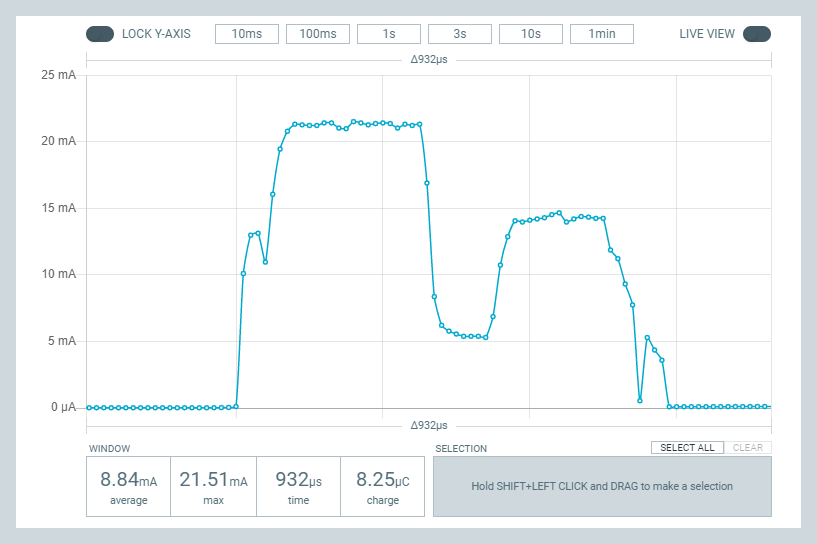
The Tx current is too high to be an nRF24L01, and it's too low to be an si24R1. I'll have to look at some of the alternative datasheets to determine just what it is.
-
@NeverDie I've been playing with KiCAD and working with your BareBones_2AA_Arduino. Given the disucssion on the "Anyone using..." thread about ground planes it jumped out at me that your design uses no ground plane. Of course there isn't any room left either. Does that matter? I see that your radio boards, like the RFM69_900 have solid ground planes.
To look at further, I looked at the ProMini design by Sparkfun. Pictures are attached of the grounded fills they used. These pictures are of only the top and bottom copper for illustration. I'm thinking this would bother Eric Bogatin and he would say to throw in another layer dedicated to ground signal. Again, do you think it matters?

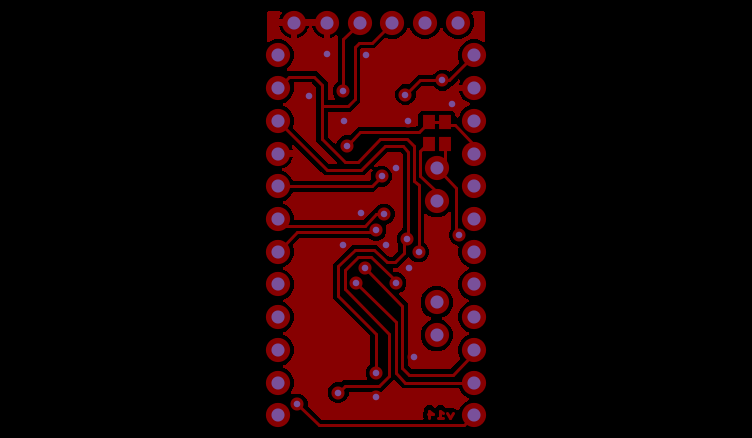
-
@Larson I think it probably does matter, but that a dipole antenna may be a good workaround to not having an optimal ground plane. I say that because a number of years ago a group of us on the lowpowerlab forum found that adding a dipole antenna to the rfm69 module resulted in a significant range improvement.
Part of the problem is that an optimally sized ground plane is actually quite large relative to an otherwise small mote, especially at sub-gigahertz frequencies. So, if you were to build an optimally sized ground plane into your PCB, your mote wouldn't be small anymore. Even a dipole antenna can be so large as to be cumbersome. This antenna: https://lowpowerlab.com/shop/product/193?search=dipole
was an outgrowth of the discussion and work that the group did, and, as you can see, it's not tiny. However, it might be feasible on a gateway, where size may not matter as much.So, short of that, should I try to add more ground plane? I really don't know. More is probably better, but I'm not smart enough to tell you how much difference a marginal increase would make. Adding a dipole antenna very definitely did make a noticeable difference though.
Maybe somebody reading this who knows more than me can comment.
Also, part of the reason I didn't add more groundplane was that it would negatively affect the current layout for the two 2.4Ghz horizontal trace antenna readios, which aren't supposed to be mounted over a ground plane. That could be rectified by moving the antenna module to the end of the board, where the trace antenna could hang off the end in empty space, but that's a version 2.0 design. Version 1.0 was just trying to get something ordered from a fab as quickly as possible, and the adapter board placement is something I would change for a v2.0. With that change, there'd be no reason not to do a copper pour and have a nice ground plane--well, within the mote's size constraints.
There's also more to it than just ground plane. There's the whole matter of impedance, which is hugely important. Smith charts, etc. I don't have more than a superficial grasp on how antennas are supposed to be designed, so I'm really the wrong person to ask about everything that's involved. From what I've read, even the particular dielectric that's used in your PCB can make a meaningful difference. Andreas Speiss did do an episode on how you can use a VNA to tune your antenna better. It might be worth a look. To me it looks like a very deep rabbit hole, and a very steep and very challenging learning curve, so it just depends how far down the rabbit hole you're willing to go. The way I see it, and maybe this is just me, I would hit diminishing returns almost immediately for the amount of effort that's required. That isn't to say that you shouldn't do it though.

-
@Larson Here's the list of nRF24L01 clones and variants: https://sigrok.org/wiki/Protocol_decoder:Nrf24l01
-
@NeverDie said in Most reliable "best" radio:
so it just depends how far down the rabbit hole you're willing to go.
I'm deep in the rabbit hole already and its getting colder and darker. Thank you for your detailed discussion - especially the diminishing-return comment. Yea, I should focus on doing and reporting back - something to show for all I have learned. I remember the 6" dia ground plane idea. Yes, that is a deal-killer. I'd opt for sheet metal befoe building a PCB that big.
Again, Thank You!
-
Not completely sure yet, but going down the list of clones/variants datasheets, but it looks as though the amazon smd "nRF24L01" modules may be using the XN297 chip:
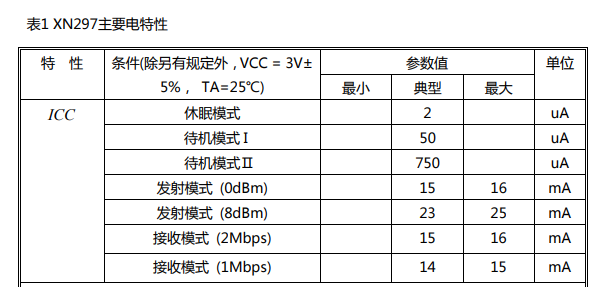
I suppose additional measurements, like sleep current and standby current, may either confirm it or not. Also, if it can't support 250kbps, that might also give it away.
According to the datasheet, it may go as high as 8dBm on Tx, so at least that would be consistent with the "enhanced power mode" advertising in the amazon.com listing.
-
Well, I checked, and the mystery modules can do 250kbps, so evidently it is not the XN297. That was my best guess, and now I have no idea what it is. The sigrok list of clones and variants hasn't been updated in many years.
-
@NeverDie said in Most reliable "best" radio:
The sigrok list of clones and variants hasn't been updated in many years.
Yes, I saw the list of 2 originals and I counted 12 clone/variants. And that list was from 2015 and it is still instructive. If the chips are compatible and deliver value, then it is sufficent for those on the learning curve, like me. Probably not sufficient for market tested commercial products.
Fun to see the Nordic employee comment about a datasheet error that ended up in a clone. I remember that paper roadmap makers from 50-years ago, like Rand, used to deliberately make mapping errors to catch clones. Times have changed and methods haven't. The die comparisons referenced in links to your link are, again, mind blowing.
-
@Larson said in Most reliable "best" radio:
If the chips are compatible and deliver value, then it is sufficent for those on the learning curve, like me
I think that's the right attitude. The main difference, aside from differences in how they handle ACK (which most software now accommodates for) is that most clones/variants are not as energy efficient as the original. For instance, this particular clone, whatever it is, has a sleep current of something like 1.5ua-1.8ua, as opposed to Nordic's 0.7ua. So, that's worse, but it may not be a deal breaker.
The newer Nordic nRF5x series chips are definitely a lot more efficient at listening, with receive currents down in the 2.6ma-~5ma range when DCDC conversion is turned on. That compares very favorably to the 15ma and up of the nRF24L01/clones. Of course, a tradeoff is cost and, these days, availability. nRF52805 is "cheap" at around $4, and it's available, so at 4.6ma in RX, it's maybe not a bad choice, considering it includes an RTC and MCU. Its sleep current with RAM retention and RTC is an improvement over the prior nRF52840 flagship. The nRF52805's native Tx power is weak, but for listening it might be adequate. I think I'll order some to try.
The current flagship is the nRF5340, which is the one that has the 2.6ma Rx current. Presently it is the only one in the nRF53x series.
-
@Larson Will be interested in your results!!

-
@NeverDie I know what you mean, but "half a wavelength apart would have them in very close proximity with risk of interference. Better if the were 300mm+half a wavelenght apart. But can mysensors cope with 2 gateways on the same frequency? I didn't think that would be possible... Or were you thinking one gateway node with 2x RF modules? Now that would be interesting!
-
@skywatch said in Most reliable "best" radio:
@NeverDie I know what you mean, but "half a wavelength apart would have them in very close proximity with risk of interference. Better if the were 300mm+half a wavelenght apart. But can mysensors cope with 2 gateways on the same frequency? I didn't think that would be possible... Or were you thinking one gateway node with 2x RF modules? Now that would be interesting!
Either way, I suppose.
Anyway, I ordered the last 10 of the nRF52805's modules from a supplier at just $2.50 each. At that price I would have bought more, but that's all they had. I think that for that price it's a very convenient integrated MCU + radio package for Rx listening and very short-range communication. I look forward to seeing whether the arduino software for the nRF52x arduino library support has noticeably improved since the last time I tried the nRF52x series. I have fond memories of programming it then, and it can only have gotten better since then. Yes? Hopefully? Funny enough a $1 si24R1 will beat it on transmission oomph, but, meh, the nRF52805 wins with 1/3 the Rx current and decently low sleep current, even with built in RTC turned on and full RAM retention.
-
@skywatch Will be interested in your results!
Here is my proposal for a test of antenna modifications that I will attempt:
- Keep it fun, light and fast.
- Use ESP8266's (ESP01's or ESP12's) because I've got some to burn.
- Antenna modifications only on either receive or transmit (recommendations?)
- Based on ESP-NOW protocol - my comfort zone.
- Report on RSSI and SNR.
- Pick one fixed range so I can keep this close to home and limited in scope.
- Most importantly, follow the hack of Pete B. and record
A. base case original
B. the 1.0, 0.75, 0.5, 0.25 wave length options
C. finally test the base case again.
Any suggestions on other points? I really don't want to burden/distract NeverDie's fine thread here, though I fear I have already. I've never hosted a thread and really don't want to. Perhaps I can post a spreadsheet somewhere.
-
@Larson said in Most reliable "best" radio:
I really don't want to burden/distract NeverDie's fine thread here, though I fear I have already.
No worries. I welcome it. Literally, any content is good content as far as I'm concerned.
-
@NeverDie said in Most reliable "best" radio:
No worries. I welcome it. Literally, any content is good content as far as I'm concerned.
You remind me of my favorite teachers/professors. I was lucky to have many.
-
@Larson Anything that brings more people to the party is a good thing. The more brains brought to bear on any given topic, the better.
-
@Larson This is kinda bluesky, but I was thinking it would be nice to have not just different radio modules to be pluggable into a test platform, but maybe even different MCU's to be similarly pluggable That way when moving from one version of the test platform to the next, you wouldn't necessarily have to desolder mcu's and other parts. I guess what I'm saying is that maybe the test platform could be either mainly or entirely a backplane that things get plugged into. Especially these days, when finding available MCU's is kinda hit or miss, and you might have to switch to a different MCU because of either price or availability. Anyhow, just putting the idea out there. I'm not at all sure what the best form of such a thing would be, but something that revolves around 2xAA batteries as the form factor makes sense to me.
-
@NeverDie I like the idea. What other mcu's were you thinking of? My limited experience, and supply, is with Atmega328P, Atmega328PB, Attiny 85, Attiny 45, ESP01, and ESP12s. I do have an assortment of PIC chips but can't claim relevant experience as I left that Microchip avenue long ago once I met the easy ArduinoIDE. The downside to multiple mcu’s is, of course, scope creep and even more infinite variations.
Pluggable? Are you thinking of making a commitment to positions for VCC, GND, several digital pins, maybe an analog pin or two like your Barebones design? Then build PCB's to that footprint for different MCU's? That sounds interesting. Kind of like a MCU/PCB/Radio sandwich.
I've been studying your Barebones board and enjoy the versatility of the pin locations' multi-functional slots for different projects. Very clever. What brought me to this was that I'm building a radio PCB for yet another radio, the RFM69HCW; the footprint is different than your RFM69HW design. The reason why is that I have 10 HCW's on hand already. I'll share it after I verify that it works. Yesterday, 4 DRF1262's arrived so I'm about to make multiple OSH Park orders. Once they arrive, I'm ready to fab since the flux, the Chipquick, the Keystone AA connectors have all arrived. I've never soldered, or desoldered, a QFN before so I'm anxious about the scavenging of the 328 from a promini. Here we go!
I am going to have to take a break from my present intensity/study. I’ve got some eldercare things coming up that will dominate my schedule. But I’ll keep in touch.
-
@Larson said in Most reliable "best" radio:
What other mcu's were you thinking of?
Well, that's the thing: not really sure. But tentatively maybe the attiny3224 or the atmega4808/4809. Attiny3324 is very low priced, and presently available, and atmega4808 is more capable than the atmega328p. atmega4808 is same mcu as the atmega4809 (used in the Arduino Nano Every), but with a lower pincount (same as the atmega328p). A counter-argument is to just stick with the atmega328p, since everybody is already familiar with it, and just pay inflated prices for it if you don't already have spares. After all, for a test platform, you don't need many anyway. And scope creep is a very good point.
[Edit: I just now did a draft. It gives up compactness, because the 14 radio pins have to be run outside of the MCU module to connect with the radio module. Well, it was worth a shot I suppose. To keep it compact, It would need a way to make connections in a very compact way, maybe like the way some of the press-fit connectors on the Pebble watch work. Yet another thing to look into. ]
-
@NeverDie said in Most reliable "best" radio:
press-fit connectors
I had to look that up. https://www.connectpositronic.com/en/press-fit-connectors/
Very interesting. Way too advanced for my Flinstone ways.Just today I completed my first KiCAD PCB. It is every bit as challenging as Eagle. Though it does offer some advantages in 'clickability' (my term).
-
@Larson said in Most reliable "best" radio:
I had to look that up. https://www.connectpositronic.com/en/press-fit-connectors/
EEVblog shows an example of one here at time index 6:50:
EEVblog #761 - Pebble Time Smartwatch Teardown – 32:40
— EEVblogIt looks way cool. There must exist something like that which doesn't need ribbon cable, where you can just press two boards together.
-
@NeverDie said in Most reliable "best" radio:
There must exist something like that which doesn't need ribbon cable, where you can just press two boards together.
Oh yea, that reminds me of a few teardowns of my own with malfunctioning displays in commercial products like temperature displays. There is some kind of foam boards that are pressed into the display contacts. I figured that they (manufacturers) were doing some complicated LCD pulsing to achieve what was needed much like the POV thing with 7-segment LED displays. Just looked: there are 20 connectors on the ribbon cable, and it was a pretty simple screen on a cheap device. I wanted to dig into it further but there were other shiny-objects that kept getting in the way.
-
@Larson said in Most reliable "best" radio:
@NeverDie said in Most reliable "best" radio:
There must exist something like that which doesn't need ribbon cable, where you can just press two boards together.
Oh yea, that reminds me of a few teardowns of my own with malfunctioning displays in commercial products like temperature displays. There is some kind of foam boards that are pressed into the display contacts. I figured that they (manufacturers) were doing some complicated LCD pulsing to achieve what was needed much like the POV thing with 7-segment LED displays. Just looked: there are 20 connectors on the ribbon cable, and it was a pretty simple screen on a cheap device. I wanted to dig into it further but there were other shiny-objects that kept getting in the way.
I think those may be called zebra connectors, if it's what I think you're referring to. I never could re-align those things. Once they're off, it seems like you need some kind of jig to realign them with enough precision. They appear to be pure electrical connectors. You need something else to provide mechanical regidity and hold everything in place.
-
@NeverDie said in Most reliable "best" radio:
It looks way cool.
Having a bit more time I watched the entire Dave Jones teardown. Very stunning review. I was feeling quite fancy after my KiCAD design but this 2015 video reminds me who I am. I am Fred Flinstone. only with Youtube. And happy enough with that!
-
@Larson said in Most reliable "best" radio:
@NeverDie said in Most reliable "best" radio:
It looks way cool.
Having a bit more time I watched the entire Dave Jones teardown. Very stunning review. I was feeling quite fancy after my KiCAD design but this 2015 video reminds me who I am. I am Fred Flinstone. only with Youtube. And happy enough with that!
Why go half-way? Let's light up some Winston's while we're at it.
 Yabba Dabba Doo!
Yabba Dabba Doo!
-
@NeverDie said in Most reliable "best" radio:
I've looked for tiny piezo's that could maybe do this, but they all seem to be different degrees of large. I know it should be possible to be tiny, becaue, for example, a digital wristwatch is able to make audible beeps. On the other hand, after looking at some teardowns, I guess digital watches uses piezo disks that are at least 1/2" in diameter. Hmmmm.... Is that really as small as it gets? Anyone here know? What about hearing aids? Surely they have something smaller. The smallest thing I've found so far has been this: https://owolff.com/page140.aspx?recordid140=534&output=pdf&delay=3000&margin=1cm which is 5mm in diameter. So, I guess forget mounting anything directly to the PCB board: wired discs are the way it's done apparently and then just tuck it somewhere inside the project enclosure.
I found these recently: https://www.cuidevices.com/micro-buzzers. Digikey seems to carry them but the smallest was listed as "0 quantity in stock" (https://www.digikey.ca/en/product-highlight/c/cui/micro-buzzers). The 4mm square version was available but of course that's just my local digikey, YMMV.
-
@NeverDie said in Most reliable "best" radio:
As a result, I just now ordered some of these E01-2G4M27D
Please let us know if they arrive with or without antennas. I've been eyeing them recently but haven't pulled the trigger yet.
-
@NeverDie said in Most reliable "best" radio:
It does already have 100n (=0.1uF) across the DC power line, extremely near the inputs to the nRF24L01
Add a 10uF cap there. I found these radios are more stable with enough power to draw on during transmission.
-
@Larson said in Most reliable "best" radio:
To extract the *.rar in Windows 10, I downloaded a utility program (WinZip 21-day trial).
7-Zip is an open-source alternative that will do the job equally as well. https://www.7-zip.org/
-
@skywatch said in Most reliable "best" radio:
@skywatch said in Most reliable "best" radio:
Thanks. What was it you were wanting me to notice about the e32 library? If it was about the FHSS, that was an e34 module in the youtube video.Oh darn it! - I got it mixed up - I am sorry for posting the wrong lib!
At about 3:12 in the video, he references the Lora E32 and says the pinout is the same and that "the software is compatible". I don't know if he means the library, the code (the module does the frequency hopping) or the Ebyte software for configuring the modules but it would be good to know more about it.
-
@alphaHotel said in Most reliable "best" radio:
@NeverDie said in Most reliable "best" radio:
I've looked for tiny piezo's that could maybe do this, but they all seem to be different degrees of large. I know it should be possible to be tiny, becaue, for example, a digital wristwatch is able to make audible beeps. On the other hand, after looking at some teardowns, I guess digital watches uses piezo disks that are at least 1/2" in diameter. Hmmmm.... Is that really as small as it gets? Anyone here know? What about hearing aids? Surely they have something smaller. The smallest thing I've found so far has been this: https://owolff.com/page140.aspx?recordid140=534&output=pdf&delay=3000&margin=1cm which is 5mm in diameter. So, I guess forget mounting anything directly to the PCB board: wired discs are the way it's done apparently and then just tuck it somewhere inside the project enclosure.
I found these recently: https://www.cuidevices.com/micro-buzzers. Digikey seems to carry them but the smallest was listed as "0 quantity in stock" (https://www.digikey.ca/en/product-highlight/c/cui/micro-buzzers). The 4mm square version was available but of course that's just my local digikey, YMMV.
Thanks! Looks as though mouser will be getting some in July: https://www.mouser.com/ProductDetail/CUI-Devices/CMT-322-65-SMT-TR?qs=pBJMDPsKWf2bBoY6kPbMAw%3D%3D
-
@alphaHotel said in Most reliable "best" radio:
@NeverDie said in Most reliable "best" radio:
It does already have 100n (=0.1uF) across the DC power line, extremely near the inputs to the nRF24L01
Add a 10uF cap there. I found these radios are more stable with enough power to draw on during transmission.
Yup, already got a 10uF cap on it on the adapter board posted to openhardware.io: https://www.openhardware.io/view/22656/nRF24L01-adapter-board
-
@alphaHotel said in Most reliable "best" radio:
@skywatch said in Most reliable "best" radio:
@skywatch said in Most reliable "best" radio:
Thanks. What was it you were wanting me to notice about the e32 library? If it was about the FHSS, that was an e34 module in the youtube video.Oh darn it! - I got it mixed up - I am sorry for posting the wrong lib!
At about 3:12 in the video, he references the Lora E32 and says the pinout is the same and that "the software is compatible". I don't know if he means the library, the code (the module does the frequency hopping) or the Ebyte software for configuring the modules but it would be good to know more about it.
I think what he's saying there is that since the FHSS E34 has a built-in mcu and is operated using AT commands over UART, the comparable UART E32 module uses the same AT commands--which is about the only way I can imagine an E34 could be drop-in compatible as a replacement for the E32. These particular types of modules are advertised and sold as "wireless UARTs", and so the underlying technology is more or less transparent to that kind of solution.
-
@alphaHotel said in Most reliable "best" radio:
E01-2G4M27D
I'm fairly certain the ones I ordered won't be arriving with antennas (as none were pictured in the aliexpress posting), but, no problem, I'll let you know for sure after they arrive. Most likely if you have an old wi-fi router that you no longer use, you could probably unscrew those antennas and use them, since they'd also be 2.4Ghz.
-
I think what he's saying there is that since the FHSS E34 has a built-in mcu and is operated using AT commands over UART, the comparable UART E32 module uses the same AT commands--which is about the only way I can imagine an E34 could be drop-in compatible as a replacement for the E32. These particular types of modules are advertised and sold as "wireless UARTs", and so the underlying technology is more or less transparent to that kind of solution.
Thanks for that explanation. It makes more sense now.
Yup, already got a 10uF cap on it on the adapter board posted to openhardware.io: https://www.openhardware.io/view/22656/nRF24L01-adapter-board
I saw that picture after I posted and smacked my head, of course, you did. On a related note, would it be possible to get the Kicad files for the nRF24L01 adapter board? I'd like to take a stab at building a couple of these but I want to put most of the face-down silkscreen on the face-up side too.
-
@alphaHotel said in Most reliable "best" radio:
I think what he's saying there is that since the FHSS E34 has a built-in mcu and is operated using AT commands over UART, the comparable UART E32 module uses the same AT commands--which is about the only way I can imagine an E34 could be drop-in compatible as a replacement for the E32. These particular types of modules are advertised and sold as "wireless UARTs", and so the underlying technology is more or less transparent to that kind of solution.
Thanks for that explanation. It makes more sense now.
Yup, already got a 10uF cap on it on the adapter board posted to openhardware.io: https://www.openhardware.io/view/22656/nRF24L01-adapter-board
I saw that picture after I posted and smacked my head, of course, you did. On a related note, would it be possible to get the Kicad files for the nRF24L01 adapter board? I'd like to take a stab at building a couple of these but I want to put most of the face-down silkscreen on the face-up side too.
Sure thing. I'm in the middle of something else at the moment, but I can post it later tonight.
-
@alphaHotel said in Most reliable "best" radio:
On a related note, would it be possible to get the Kicad files for the nRF24L01 adapter board?
Done. Posted the .rar file to the project files. Let me know if you have any difficulty with it.
There was an error in the original: it didn't identify the IRQ pin on the backside silkscreen. I fixed that on the next (experimental) version (which is also wider), which I haven't yet received from the fab. However, the silkscreen images are here:
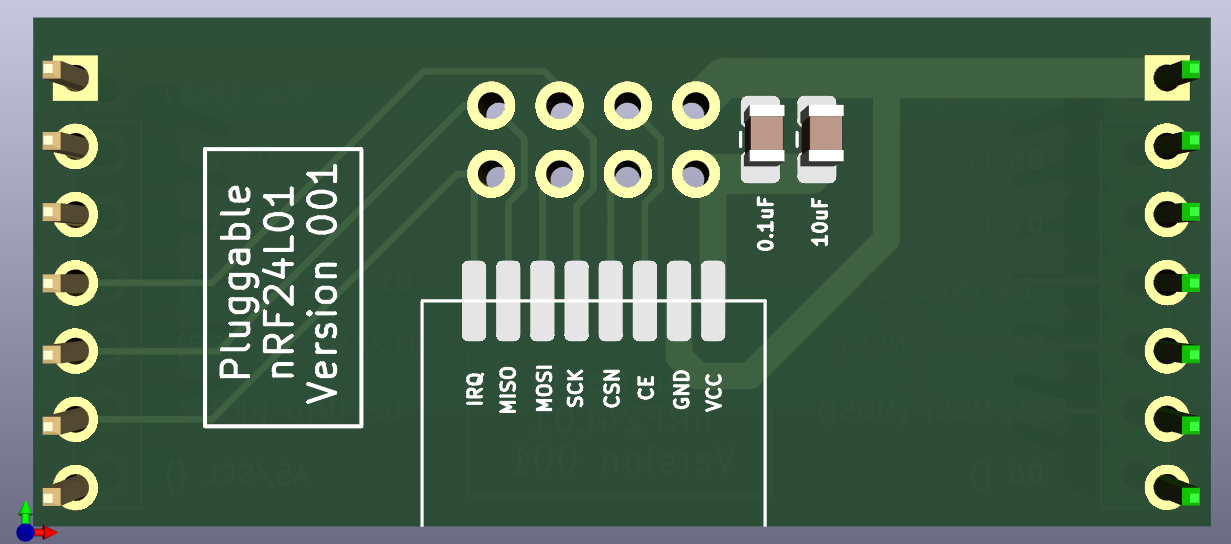
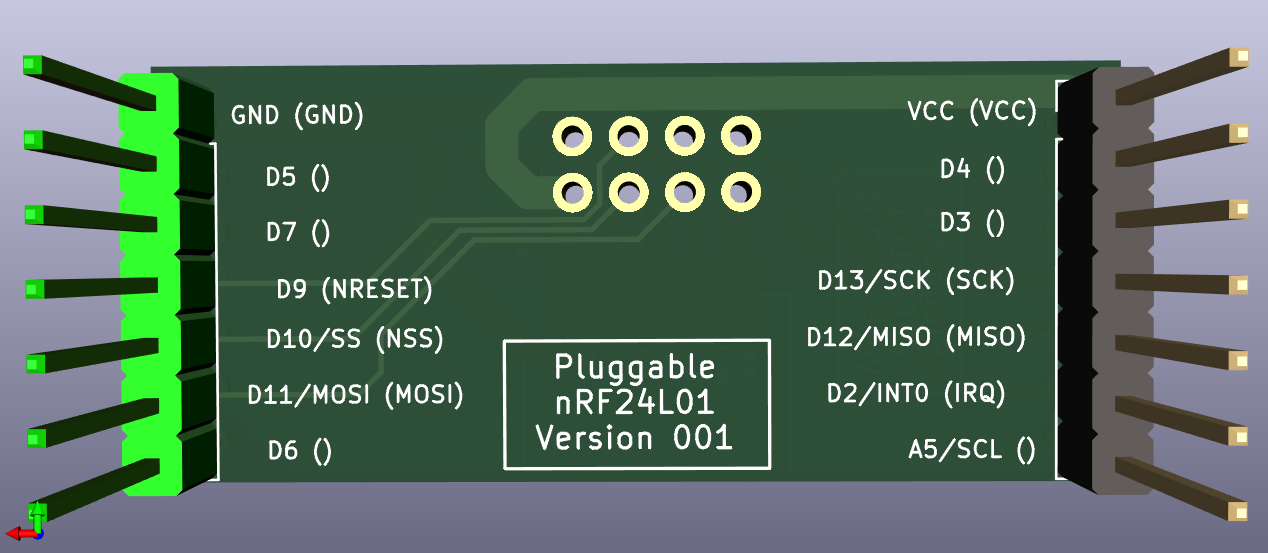
Hope that helps!
P.S. In case you're wondering, the possible next version has not only pluggable radios (as the original version had), but also pluggable MCU's, to make it easier to try different MCU's. I'm not sure yet whether or not it's a good idea, but since it's not rocket surgery I figure it is just easier to try the idea out than to overthink it.
-
@alphaHotel Thanks for asking for the program files. I was too shy.
@NeverDie You do fine work! Thanks for the NRF24 updates to openhardware.io.
Today I placed a bundle of orders for your boards and one of mine (RFM69HCW) at OSH Park. I wanted to send you the RFM69HCW board on this forum. But, I just learned that I can't send a zip, nor sch, nor board files through MySensors. That is very smart and prudent of them. I'll do as you do and am sending the jpg files that I derived from KiCAD. You will notice my plagerism of your broad power traces and narrow signal lines. So very fine. Let me know if there is a way to share the files with you, if you are interested. I'm not ready for an openhardware.io account just yet.
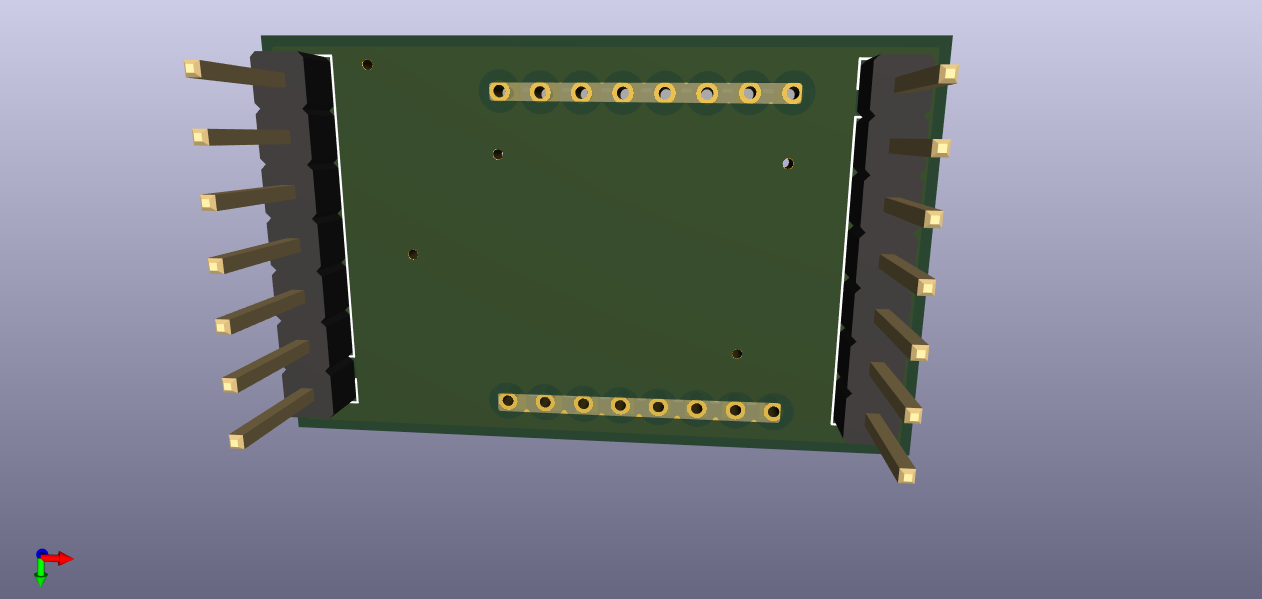
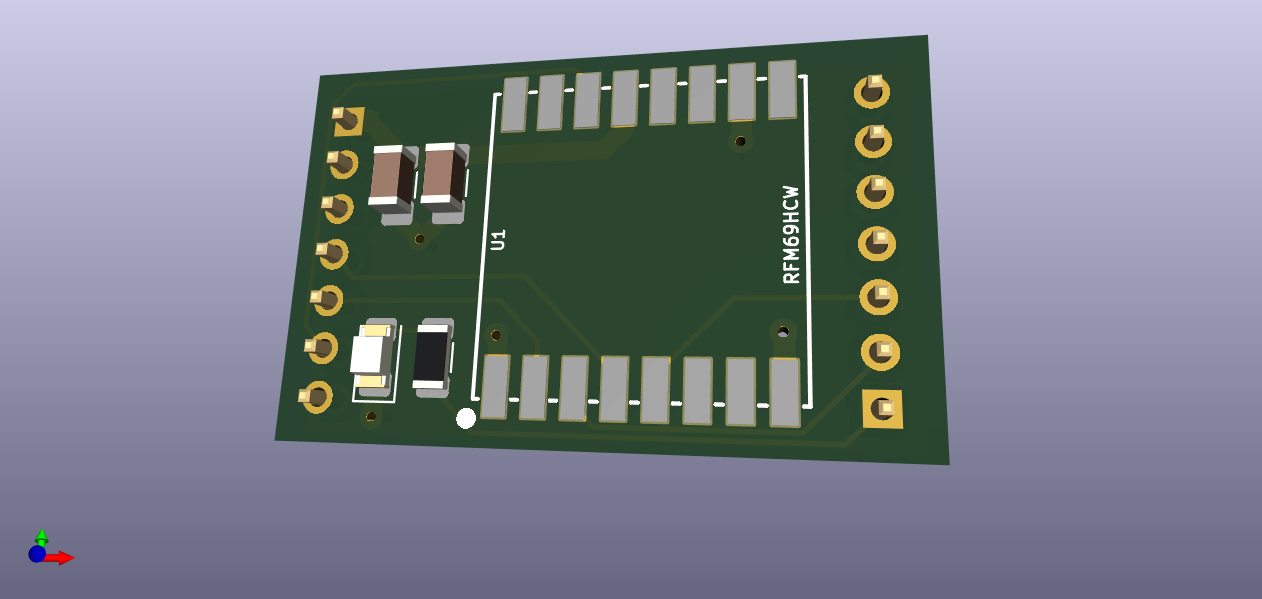
-
@NeverDie said in Most reliable "best" radio:
Yabba Dabba Doo!
You were there! What a great cartoon. It was a shame they didn't have stone PCB's. They would have used mica.
-
@Larson Congrats on finishing your first KiCAD PCB. Once you're over that hump, it just keeps getting easier.
I don't think there's any harm to posting to openhardware.io. It's' pretty well designed so that people who just want to buy stuff can look at finished projects and not be bothered by work in progress. To the extent you can eventually finish a project, then it helps mysensors. As for me, I think I'm pretty much done with RFM69, but maybe someone else would be interested.
-
This is what I came up with for a platform that has both pluggable MCU's and pluggable radios:
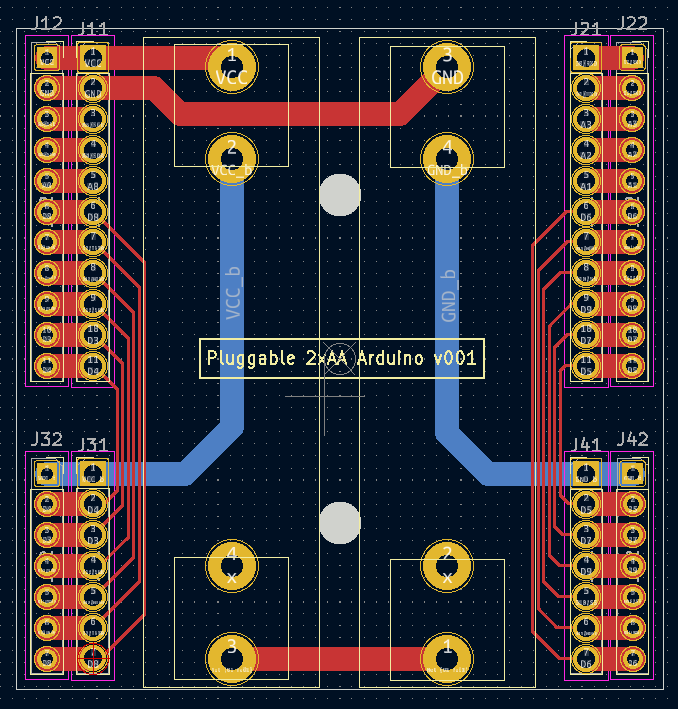
It's a bit wider than the previous test platform to give enough space between both the two AA batteries themselves and between those batteries and the pin headers. It also has a separate row of pins along the outside in case you want to have any shields that go on top. I did away with the switch entirely. Now if you want to power it off, you just remove a battery. So, doing all that renders the backplane/power-source very simple. Also, I included two mounting holes so that the whole thing can be mounted inside a project box. Yesterday I ordered this PCB along with a pluggable atmega328p MCU board and a pluggable radio board from a fab, so nothing physical to show-and-tell just yet.
-
@NeverDie said in Most reliable "best" radio:
Done. Posted the .rar file to the project files. Let me know if you have any difficulty with it.
Thank you. I didn't have any issues with the files though it did warn that the footprints for the radio modules are in
MyGlobalLibrary, which I don't have. See the screenshot below. If they could be put into a library within the project, it would be more portable than it already is but I was able to work with it as is.
I made a few mods including adding a ground plane and I'll try to get a repo on GitHub up and running for it tonight after work. With a new version in the works, perhaps I'll hold off getting some of these boards fabricated. In the interim, here's a view of my 3D model.
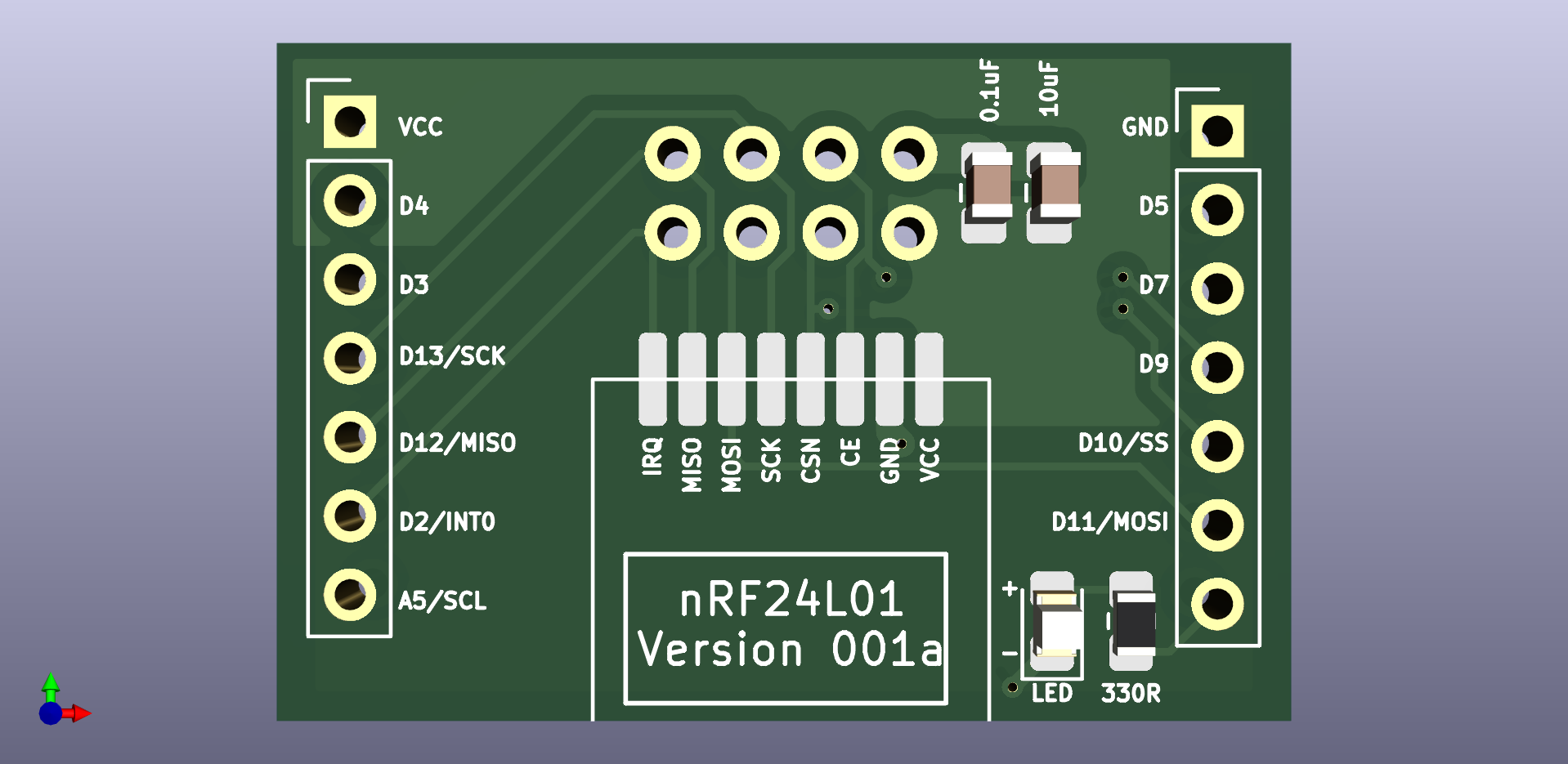
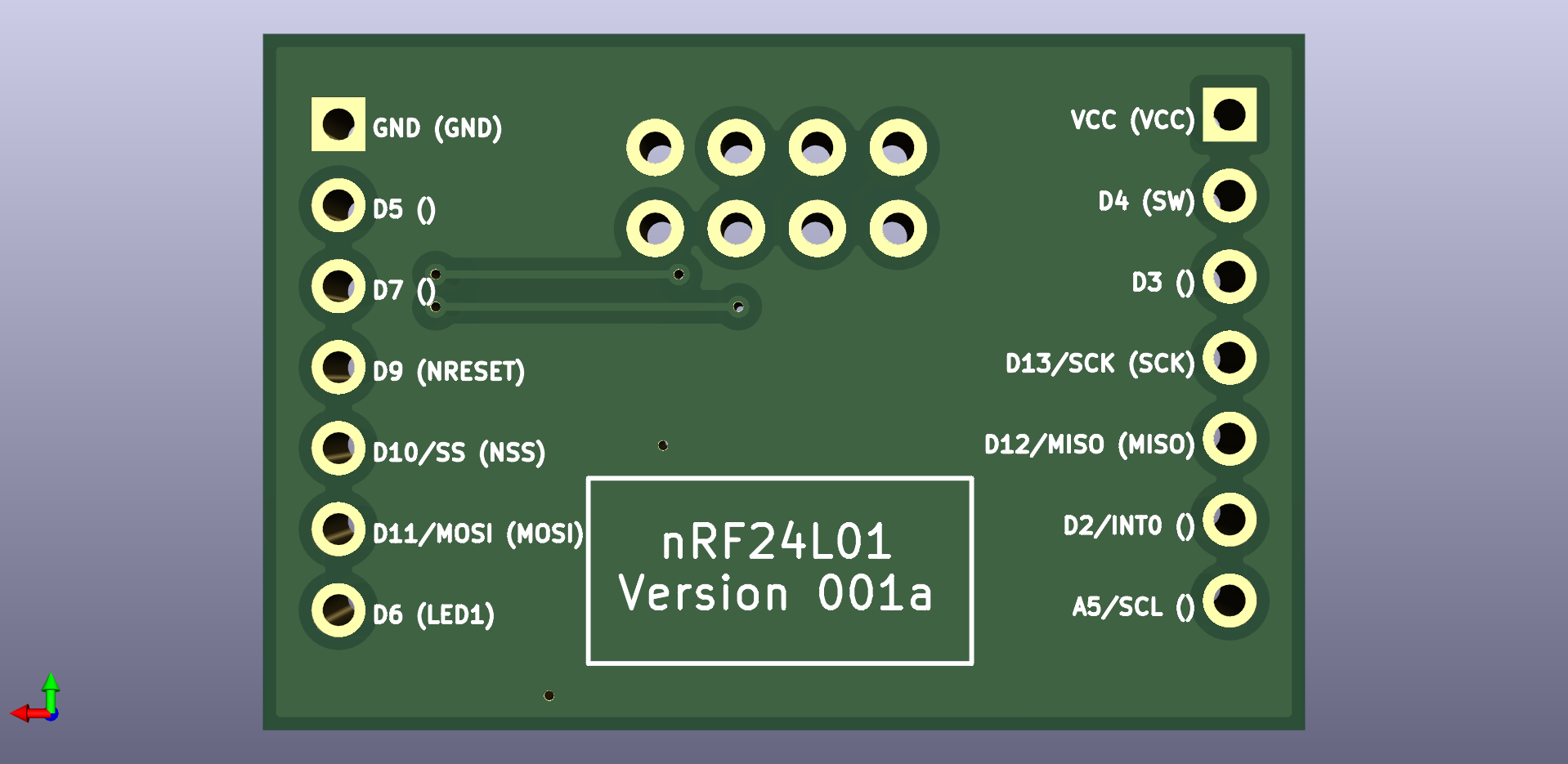
P.S. In case you're wondering, the possible next version has not only pluggable radios (as the original version had), but also pluggable MCU's, to make it easier to try different MCU's. I'm not sure yet whether or not it's a good idea, but since it's not rocket surgery I figure it is just easier to try the idea out than to overthink it.
At one point in this thread, I marvelled at the battery shield and wondered about having it separated from the MCU. Just conditioned power on the first shield then MCU, then radio. The complexity of it though is beyond my current level as I don't have as much experience with alternative MCU's (though I've been thinking we need to start looking at something with more program memory, like the ATmega4808/9). On the other hand, it should be just a matter of defining what needs to be passed from shield to shield (layer to layer?). Power, ground, SPI signals, perhaps I2C signals and a few other GPIO signals. Please do though consider lining up the pins such that they would also fit a breadboard layout.
-
@NeverDie With the first version of the battery/MCU board, you lamented running traces directly under the batteries. You have the space now to re-route them but choose not to. Did you find a way to resolve the issue it caused?
-
@alphaHotel said in Most reliable "best" radio:
@NeverDie With the first version of the battery/MCU board, you lamented running traces directly under the batteries. You have the space now to re-route them but choose not to. Did you find a way to resolve the issue it caused?
Actually, I fixed it on the new version (pictured above). The red traces run on top, so they're adequately isolated from the battery holder metal, which is on the back side except for the through-holes where it sticks through the board. Where I ran into trouble was running traces on the back side, beneath the battery holder metal. If the battery holder metal was pressed up hard against the board, some shorts resulted on some of the boards. The workaround was to not press the battery holder metal hard up against the board, but the new version removes that concern entirely.
-
@alphaHotel said in Most reliable "best" radio:
On the other hand, it should be just a matter of defining what needs to be passed from shield to shield (layer to layer?). Power, ground, SPI signals, perhaps I2C signals and a few other GPIO signals.
Yup, you got it. That's all there is to it. Power, ground, SPI, chip enable, chip select, maybe RX/TX enable (on some radios), and enough interrupt pins to take advantage of whatever interrupt or DIO pins the radio has to offer up. Looking back on it, I probably should have kept A5 off of the radio module, since that's used by I2C, and used some other pin instead. So... it's still a work in progress, but getting better.
-
@alphaHotel said in Most reliable "best" radio:
I didn't have any issues with the files though it did warn that the footprints for the radio modules are in MyGlobalLibrary, which I don't have. See the screenshot below. If they could be put into a library within the project, it would be more portable than it already is but I was able to work with it as is.
Thanks for the feedback. I really would like it to be both portable and standalone, so I'll look into setting up a standalone library to include into the .rar that will make for a better KiCAD 6 project archive.
-
@NeverDie said in Most reliable "best" radio:
@alphaHotel said in Most reliable "best" radio:
@NeverDie With the first version of the battery/MCU board, you lamented running traces directly under the batteries. You have the space now to re-route them but choose not to. Did you find a way to resolve the issue it caused?
Actually, I fixed it on the new version (pictured above). The red traces run on top, so they're adequately isolated from the battery holder metal, which is on the back side except for the through-holes where it sticks through the board. Where I ran into trouble was running traces on the back side, beneath the battery holder metal. If the battery holder metal was pressed up hard against the board, some shorts resulted on some of the boards. The workaround was to not press the battery holder metal hard up against the board, but the new version removes that concern entirely.
Okay, I see now. I misunderstood the original issue and also didn't think about the top/bottom side orientation in relation to those traces vis-a-vis the battery holders. Thanks for clarifying.
-
@alphaHotel said in Most reliable "best" radio:
I didn't have any issues with the files though it did warn that the footprints for the radio modules are in MyGlobalLibrary, which I don't have. See the screenshot below. If they could be put into a library within the project, it would be more portable than it already is but I was able to work with it as is.
OK, I updated the project archive to include nRF24L01 symbol and footprint libraries which include those symbols and footprints. Let me know if it works out OK.
Apparently best practice is to put literally every single symbol and footprint that gets used on a project into project-specific libraries so that they can be freely shared. At least for now I just put in the unique nRF24L01 symbols and footprints that aren't part of the generic KiCAD 6 build.
-
@alphaHotel said in Most reliable "best" radio:
Please do though consider lining up the pins such that they would also fit a breadboard layout.
Yes, agreed. Unless I made an error, this should already be true.
-
@NeverDie said in Most reliable "best" radio:
OK, I updated the project archive to include nRF24L01 symbol and footprint libraries which include those symbols and footprints
Awesome! Thank you.
-
UPDATE:
- I've created a Github repo for my version of the nRF24L01 adapter board.
- I've created an OpenHardware.io project for it referencing the Github repo to extract/generate the files.
- My OpenHardware.io project
is being reviewed before it is published. When its availableyou'll find it at https://www.openhardware.io/view/32973/nRF24L01-Adapter-Board-AH.
I've done it this way partly as a test as it ties back to this thread about sharing a complete set of KiCad design files. I'd appreciate any feedback on being able to open and edit the files. Also, feel free to submit a pull request as a test of collaborating with Github and KiCad but only if you're interested in the results too.
Edit: OpenHardware.io project is now available publicly.
-
@Larson A bit late as the dry weather has me doing outdoors work and I'm knackered!
But yes, I agree with your thoughts and method as a good solid starting point. I would clamp the modules in place so they cannot move at all and do first test, then solder wire to one module in situ and do test 2, then finally solder wire to second module and do test 3.
This way you get to cover all possibilities in the shortest steps and time with minimal messing.
-
@skywatch said in Most reliable "best" radio:
@Larson A bit late as the dry weather has me doing outdoors work and I'm knackered!
But yes, I agree with your thoughts and method as a good solid starting point. I would clamp the modules in place so they cannot move at all and do first test, then solder wire to one module in situ and do test 2, then finally solder wire to second module and do test 3.
This way you get to cover all possibilities in the shortest steps and time with minimal messing.
Great. Thanks for your review. It may take me a couple of weeks to get to it.
-
@alphaHotel said in Most reliable "best" radio:
UPDATE:
I've created a Github repo for my version of the nRF24L01 adapter board.
Thanks for the version. I have made a few tweaks to your version. I don't have an openhardware account, yet, but will make one when I have the time. In the meanwhile below are the pictures of my changes. In words:
- I shrank the frame of the board to minimize the interference with the TestPlatform neighboring pins
- rerouted two traces to make the ground plane cleaner
- moved some components as needed
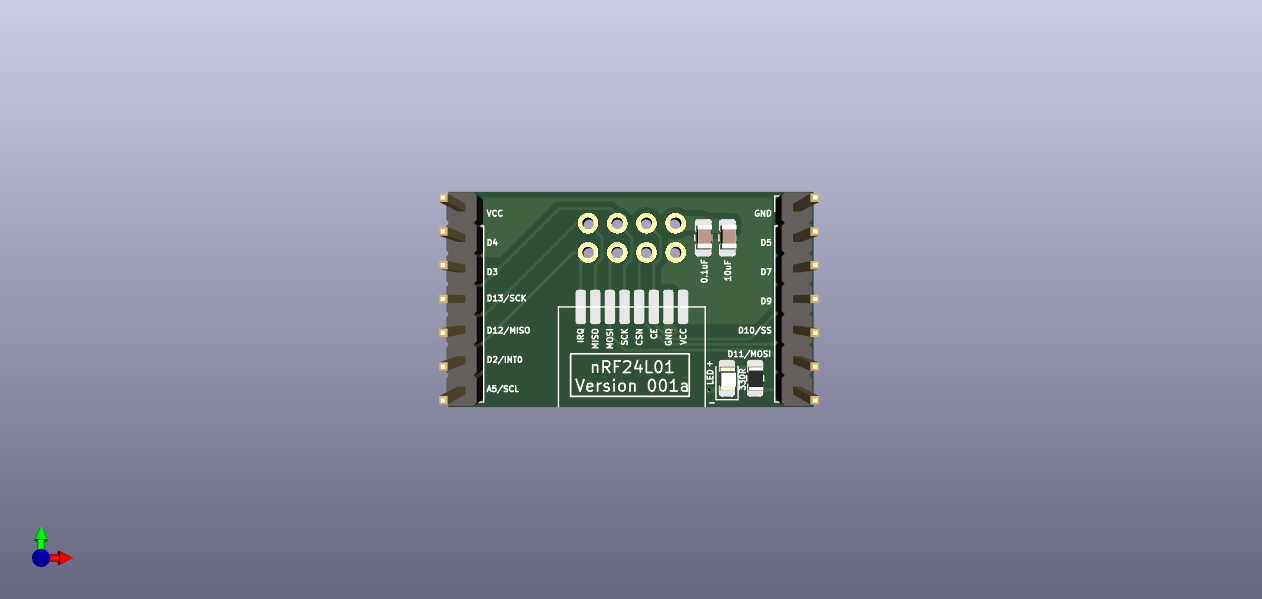
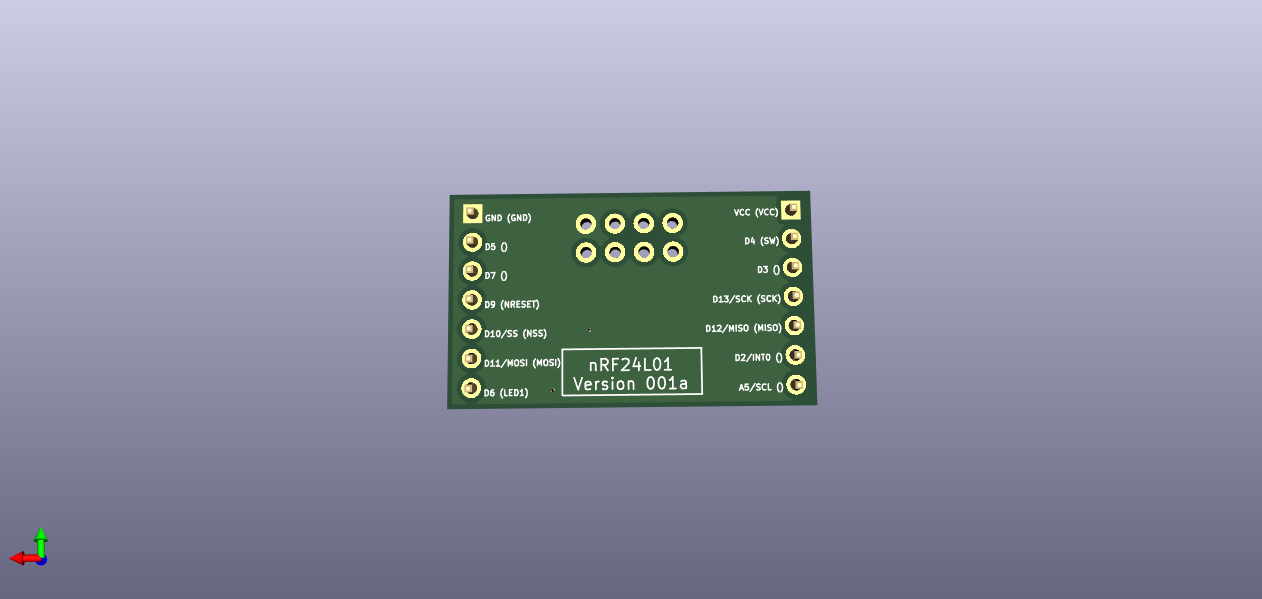
-
@alphaHotel said in Most reliable "best" radio:
@NeverDie said in Most reliable "best" radio:
I've looked for tiny piezo's that could maybe do this, but they all seem to be different degrees of large. I know it should be possible to be tiny, becaue, for example, a digital wristwatch is able to make audible beeps. On the other hand, after looking at some teardowns, I guess digital watches uses piezo disks that are at least 1/2" in diameter. Hmmmm.... Is that really as small as it gets? Anyone here know? What about hearing aids? Surely they have something smaller. The smallest thing I've found so far has been this: https://owolff.com/page140.aspx?recordid140=534&output=pdf&delay=3000&margin=1cm which is 5mm in diameter. So, I guess forget mounting anything directly to the PCB board: wired discs are the way it's done apparently and then just tuck it somewhere inside the project enclosure.
I found these recently: https://www.cuidevices.com/micro-buzzers. Digikey seems to carry them but the smallest was listed as "0 quantity in stock" (https://www.digikey.ca/en/product-highlight/c/cui/micro-buzzers). The 4mm square version was available but of course that's just my local digikey, YMMV.
Adafruit's Clue device uses the KLJ-5030, which is 5mmx5mmx3mm: https://www.aliexpress.com/item/2251832675250640.html?spm=a2g0o.productlist.0.0.4ef473807sKXlG&algo_pvid=a8ed0732-081a-414b-8b9a-5745c9f7e7ff&algo_exp_id=a8ed0732-081a-414b-8b9a-5745c9f7e7ff-1&pdp_ext_f={"sku_id"%3A"65468584514"}&pdp_npi=2%40dis!USD!!47.0!47.0!!!!%402101e9d016559352842771526eafc4!65468584514!sea
At higher cost I notice that there also exists a KLJ-4020, which is 4mmx4mmx2mm: https://www.aliexpress.com/item/2251832613970385.html?spm=a2g0o.detail.1000060.1.58582227hEwQ40&gps-id=pcDetailBottomMoreThisSeller&scm=1007.13339.274681.0&scm_id=1007.13339.274681.0&scm-url=1007.13339.274681.0&pvid=6e57d5b5-3669-4301-96cd-4254603eb5f8&_t=gps-id:pcDetailBottomMoreThisSeller,scm-url:1007.13339.274681.0,pvid:6e57d5b5-3669-4301-96cd-4254603eb5f8,tpp_buckets:668%232846%238110%231995&pdp_ext_f={"sku_id"%3A"66402727672"%2C"sceneId"%3A"3339"}&pdp_npi=2%40dis!USD!!13.0!13.0!!!!%40210323b116559355333711431e5503!66402727672!rec
-
@NeverDie said in Most reliable "best" radio:
Adafruit's Clue device uses the KLJ-5030, which is 5mmx5mmx3mm:
At higher cost I notice that there also exists a KLJ-4020, which is 4mmx4mmx2mmYikes!
 Watch out for those shipping costs. Check my math, 4mm x 4mm x 2mm x 20 pcs = 640 cubic mm = 0.640 cubic cm = 0.0391 cubic inches, from China for $72 shipping? They must weigh a ton (or a tonne). LOL!
Watch out for those shipping costs. Check my math, 4mm x 4mm x 2mm x 20 pcs = 640 cubic mm = 0.640 cubic cm = 0.0391 cubic inches, from China for $72 shipping? They must weigh a ton (or a tonne). LOL! 
Seriously though, good find! I think I'll keep shopping around for a better price though.

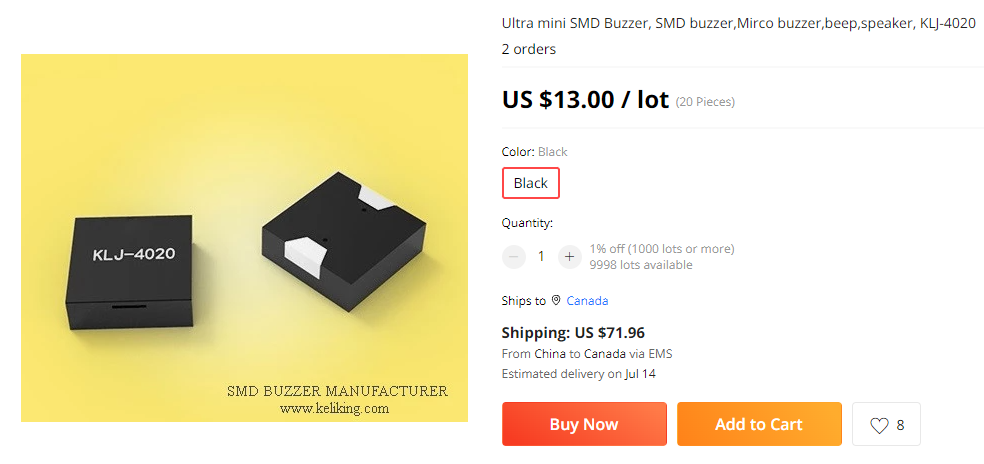
-
@Larson said in Most reliable "best" radio:
I shrank the frame of the board to minimize the interference with the TestPlatform neighboring pins
Nice! How wide is that VCC trace/plane at its narrowest point now?
If you got it from Github, are you able to send me a pull request?
-
@alphaHotel said in Most reliable "best" radio:
@NeverDie said in Most reliable "best" radio:
Adafruit's Clue device uses the KLJ-5030, which is 5mmx5mmx3mm:
At higher cost I notice that there also exists a KLJ-4020, which is 4mmx4mmx2mmYikes!
 Watch out for those shipping costs. Check my math, 4mm x 4mm x 2mm x 20 pcs = 640 cubic mm = 0.640 cubic cm = 0.0391 cubic inches, from China for $72 shipping? They must weigh a ton (or a tonne). LOL!
Watch out for those shipping costs. Check my math, 4mm x 4mm x 2mm x 20 pcs = 640 cubic mm = 0.640 cubic cm = 0.0391 cubic inches, from China for $72 shipping? They must weigh a ton (or a tonne). LOL! 
Seriously though, good find! I think I'll keep shopping around for a better price though.


Yeah, the price is awful. I only linked it as an example. Looking a bit harder, I see they can be had for $1.53 each from a more reliable source: https://www.lcsc.com/product-detail/Buzzers_KELIKING-KLJ-4020_C556936.html The other thing to be wary regarding it is that the manufactures website says is only audible within a 0.5 to 1m range, which, if true, would be pathetically weak.
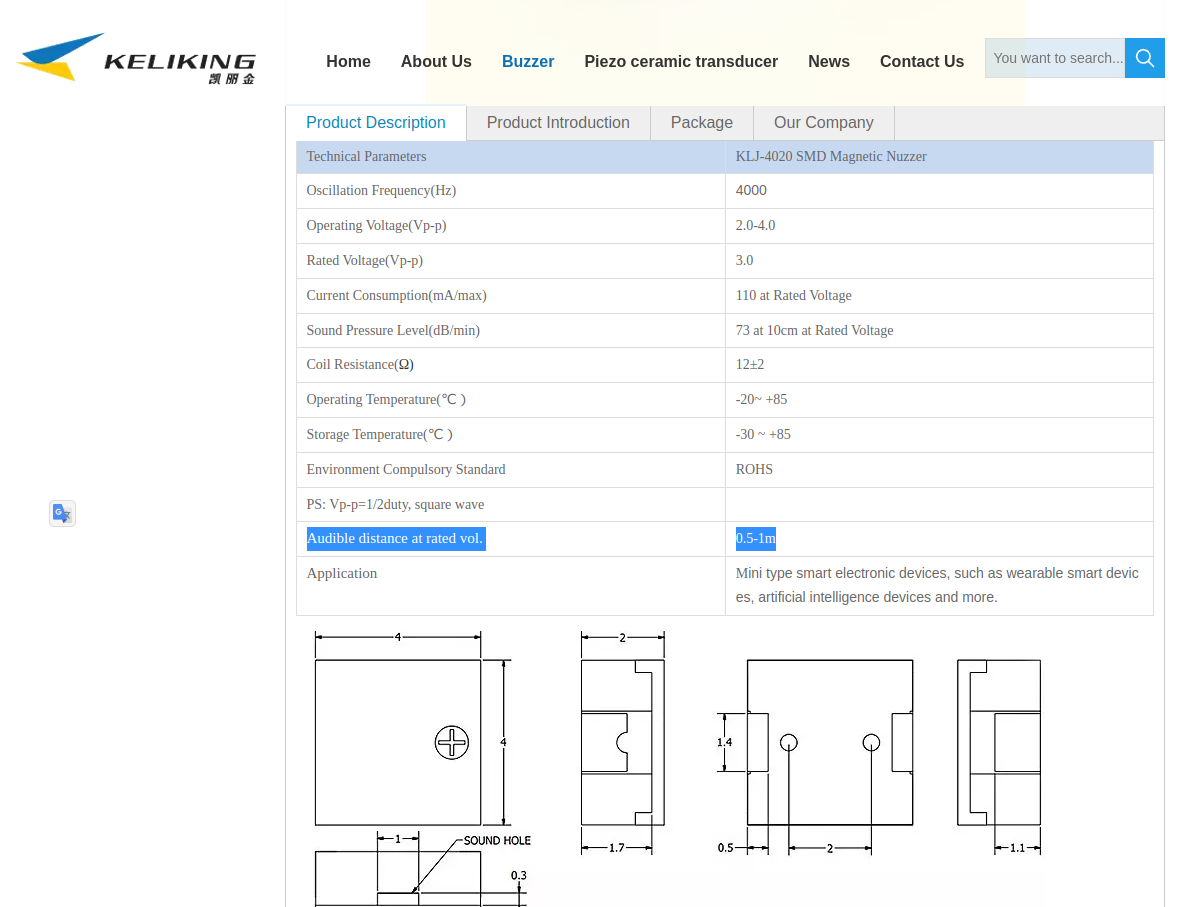
So, it has me thinking "close but no cigar."In comparison, having heard it myself, the KLJ-5030 is reasonably loud I would say.
-
Looks as though FUET has some good low-priced alternative buzzers:
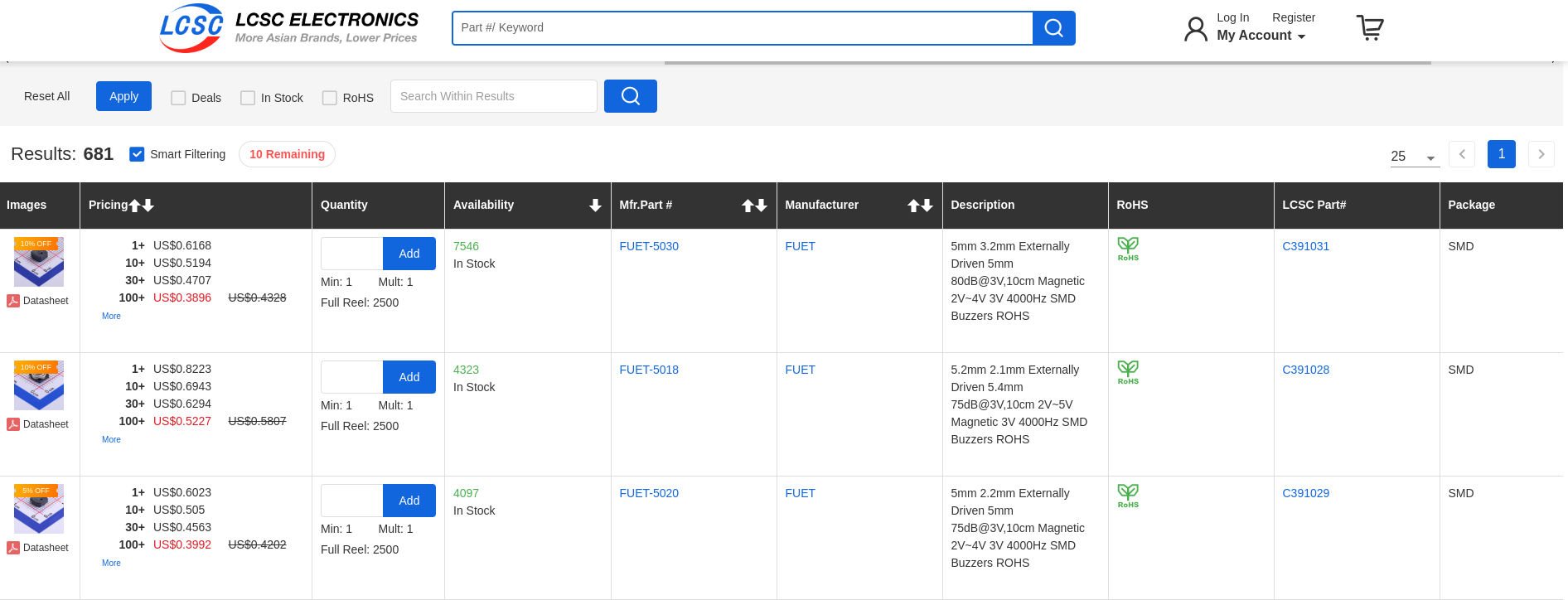
It must be something about the physics of buzzers that the thinnner they get in these small packages, the quieter they are.
-
@alphaHotel said in Most reliable "best" radio:
Nice! How wide is that VCC trace/plane at its narrowest point now?
KiCad tells me the narrowest VCC trace is about 0.045" (1.1 mm). I think the conventional 0.5 oz. copper is the common underlayment thickness. Is it too narrow? The return path is much narrower (Pin 1 nRF24L01). Does that matter?
@alphaHotel said in Most reliable "best" radio:
If you got it from Github, are you able to send me a pull request?
Yes, I think I got your version from Github. I will learn how to send a pull request. Cool, so this is how collaboration works? I'm new to this.
-
@NeverDie said in Most reliable "best" radio:
It must be something about the physics of buzzers that the thinnner they get in these small packages, the quieter they are.
I'm thinking of speakers of the 1970's: the drivers, midrange and tweeters would be nothing without the cabinet boxes. Does that apply here? In the 2010's these "soundbars" come into the picture. But there is still a box involved. Yes, it is probably about the physics of sonics... I'm thinking.
-
@Larson said in Most reliable "best" radio:
Yes, I think I got your version from Github. I will learn how to send a pull request. Cool, so this is how collaboration works? I'm new to this.
Please don't add to your personal learning curve to create a pull request. It's not that important, at all.
-
@NeverDie said in Most reliable "best" radio:
This is what I came up with for a platform that has both pluggable MCU's and pluggable radios:

It's a bit wider than the previous test platform to give enough space between both the two AA batteries themselves and between those batteries and the pin headers. It also has a separate row of pins along the outside in case you want to have any shields that go on top. I did away with the switch entirely. Now if you want to power it off, you just remove a battery. So, doing all that renders the backplane/power-source very simple. Also, I included two mounting holes so that the whole thing can be mounted inside a project box. Yesterday I ordered this PCB along with a pluggable atmega328p MCU board and a pluggable radio board from a fab, so nothing physical to show-and-tell just yet.
In terms of having "plugable" compute modules, I'm thinking that maybe edge connectors might be a good way to go. I say that because I've lately been looking at expansion slots for the Adafruit CLUE, which has a similar pinout to the BBC micro:bit. Even though those modules have only a little more than 20 pins to expose, some of the edge connectors on the market that are compatible with them can support as many as 80 pins! For a plugable compute module, the more pinouts the better. That way, if you need access to a lot more pins, you would simply plug the same compute module into a backplane that gives you access to a lot more pins to, for example, directly drive an LCD display instead of having to do it all (more slowly) using an SPI interface.
Well, that's all I've learned so far. I guess in the absence of any better ideas, maybe picking one of those 80 pin edge connectors that's compatible with micro:bit would perhaps be a worthwhile experiment to build a plugable backplane around. Especially for mcu's that come with a switchable fabric that can re-assign which logical pins are assigned to which physical pins, it would perhaps open up a lot of options for exploiting much more capable MCU's while still keeping the real estate small.
Here's an example of one of those 80 pin edge connectors that's micro:bit compatible: https://www.amazon.com/gp/product/B08HS27D51/ref=ox_sc_saved_title_3?smid=A22NPL1KB8AOV0&psc=1

as well as a PCB showing how it is wired for a micro:bit:
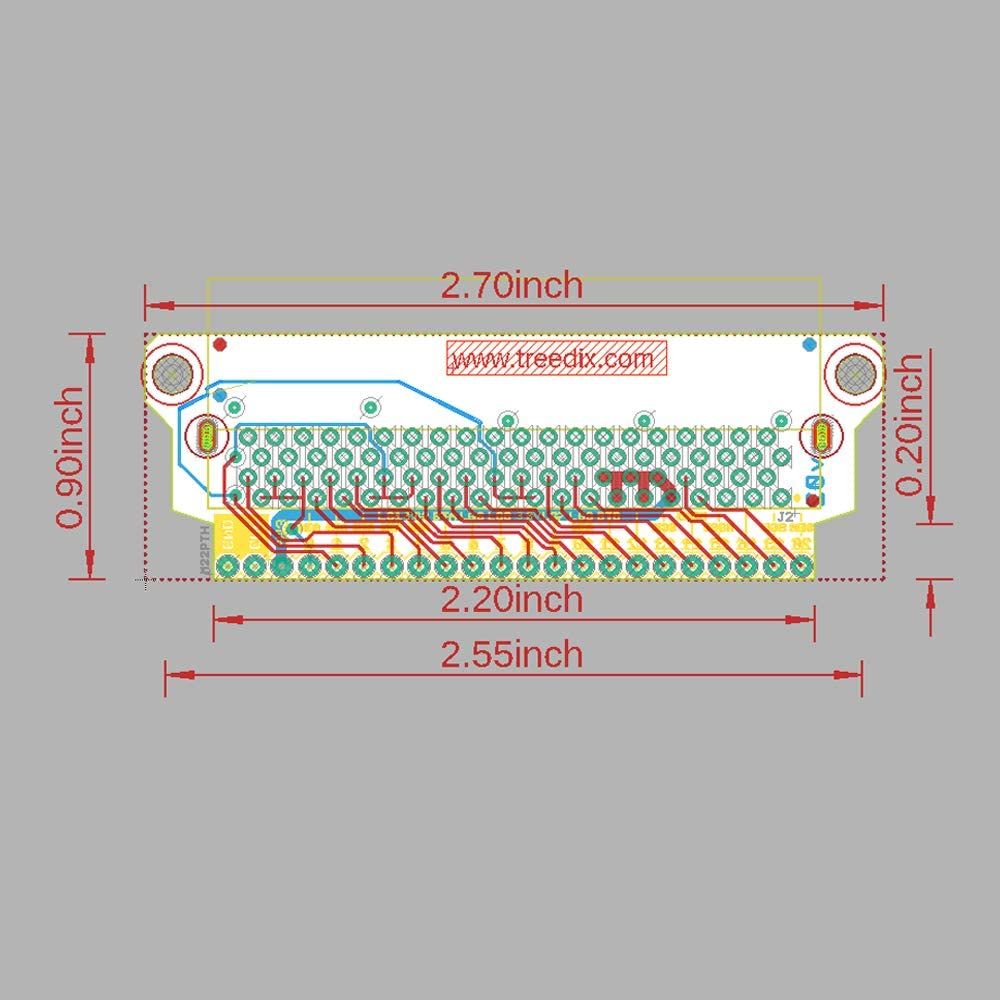
As you can see, lots of room to grow! The downside is that it's not small. Maybe an edge connector that's half as long would work well enough (though obviously sacrifice micro:bit compatability) and still keep things small. If there were a smaller, much higher connection density connector, that would obviously be better. Maybe @Larson 's idea of using zebra strips as connectors is more practical. Not sure. I suppose in a way the little aliexpress modules, with their array of contacts on the back of their little PCB's, are a type of connector, just not a plugable/unplugable one.Anyhow, I don't have the time to pursue it further at this juncture, so those are just some notes to either future self or to anyone who might want to tackle it.
-
I was thinking of trying out the nRF52805, but it turns out making the nRF5 jump now isn't much easier than it was 5 years ago when I last looked into the nRF52 series. The main improvement in the interim is that certain popular chips, like the nRF52840 are now better supported, because they are baked into things like the Adafruit CLUE and have at least some familiar Arduino support.
-
@NeverDie said in Most reliable "best" radio:
Maybe @Larson 's idea of using zebra strips as connectors is more practical.
I learned about zebra strips from you - thank you very much. I was unable to re-establish connections for an existing commercial products and I don't know why. My thought was that zebra strips were some technology and complex signaling that is beyond my capacity. The device is probably over 20 years old. Therefore, I would not recommend zebra strips because I don't know enough about them.
This pic from your link is more telling of the capability of your referenced connectors.
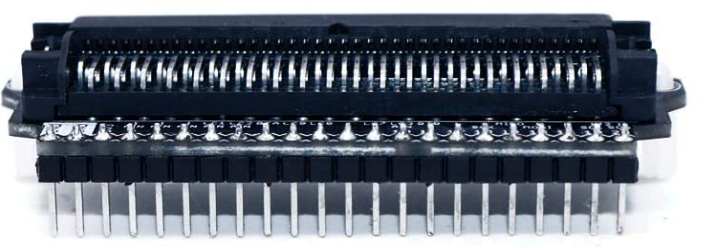 For now, I don't know why these are called edge-connectors. I thought edge-connectors were flat male blades with double-sided contacts that were fitted in sloted female gaps. The ones I think I've seen have an index slot for, I suspected, polarity protection and alignment. Maybe I've got this all wrong and they are called something else - like card connectors.
For now, I don't know why these are called edge-connectors. I thought edge-connectors were flat male blades with double-sided contacts that were fitted in sloted female gaps. The ones I think I've seen have an index slot for, I suspected, polarity protection and alignment. Maybe I've got this all wrong and they are called something else - like card connectors.
-
@Larson said in Most reliable "best" radio:
don't know why these are called edge-connectors.
@Larson I think they're called edge connectors because they mate with the edge of a PCB.
-
@NeverDie Yes, I think we are surfing the same wave. I'm thinking of a PCB mount that will recieve a perpendicular PCB board with double sided connectors like this: https://www.ebay.com/itm/122943051785?hash=item1c9ffa1809:g:daAAAOSwd4tTxdNW
Maybe there is an application of these for the radio modules that have the single row SMD mounting pads? One would need to ignore the opposing connectors. Better yet, maybe there are radio boards (?) that could be designed to slot in... just thinking. The NRF24’s would require double-sided 1x4 board and receivers. That would be cool and compact.
But then there is the ground-plane to think about?
-
@NeverDie said in Most reliable "best" radio:
CORRECTION: Earlier I said that Adafruit's TPL5110 breakout board appeared to use a 1M pulldown resistor on DONE. I remeasured today and that's wrong. It's actually a 10K resistor.
Thanks for redirecting me to this thread. I think you were right on your original 1M Ohm assertion. Since I'm playing with my new TPL5110,s I took it on to make my own MM measurements. While my Harbor Freight MM might not be the most accurate instrument, I did show the resistance between DONE and GND to be 900 K'ish. Next, I got out the magnifying glass to spy the resistor in-line with said pins to have a marking of 1004. Google affirmed that that means 1 M ohm. So, your 5K, or 10K would be a big change – and if it comes at no cost for the quiescent current AND enables ESP action, then perfect!
-
@Larson said in Most reliable "best" radio:
@NeverDie said in Most reliable "best" radio:
CORRECTION: Earlier I said that Adafruit's TPL5110 breakout board appeared to use a 1M pulldown resistor on DONE. I remeasured today and that's wrong. It's actually a 10K resistor.
Thanks for redirecting me to this thread. I think you were right on your original 1M Ohm assertion. Since I'm playing with my new TPL5110,s I took it on to make my own MM measurements. While my Harbor Freight MM might not be the most accurate instrument, I did show the resistance between DONE and GND to be 900 K'ish. Next, I got out the magnifying glass to spy the resistor in-line with said pins to have a marking of 1004. Google affirmed that that means 1 M ohm. So, your 5K, or 10K would be a big change – and if it comes at no cost for the quiescent current AND enables ESP action, then perfect!
I just now checked the adafruit schematic for the TPL5110, and you're right: it does show a 1 megaohm resistor. I guess I must have measured it wrong. https://github.com/adafruit/Adafruit-TPL5110-Power-Timer-Breakout-PCB
-
@NeverDie said in Most reliable "best" radio:
@alphaHotel said in Most reliable "best" radio:
E01-2G4M27D
I'm fairly certain the ones I ordered won't be arriving with antennas (as none were pictured in the aliexpress posting), but, no problem, I'll let you know for sure after they arrive. Most likely if you have an old wi-fi router that you no longer use, you could probably unscrew those antennas and use them, since they'd also be 2.4Ghz.
@alphaHotel Reporting back: I received them, and mine did not come with any antennas.
-
@NeverDie said in Most reliable "best" radio:
@alphaHotel Reporting back: I received them, and mine did not come with any antennas.
That's as I expected too because of the lack of any photos in the listings. Thanks for confirming, it's good to know. I do have a handful lying around from old WiFi routers as you mentioned.
-
I've had success getting the nRF24L01 to listen once per second for packets at an average current drain for just the nRF24L01 of 5.35ua. Not bad! The snag I'm running into though is that the listen window, encompassing power-up of the nRF24L01 through Rx mode is 1.6ms. However, if I use the atmega328p to time that 1.6ms, it raises the average current drain to 45ua, which is worse than my keyfinder keyfob's current drain (about 30ua on average). So....I need to find some way to sleep the atmega328p for 1.6ms in order to keep the total current drain low. However, how to do that? The TPL5111 has a minimum period of 100ms, so that's out. The atmega328p's WDT has a minimum period of 16ms, so that's out too. Unfortunately, the atmega328p has no built-in RTC. Even if I were to add an external RTC, I don't know of any that would let me dial-in 1.6ms.
Presently I can think of only two solutions:
-
Add some kind of external oscillator and feed it to Timer2 in asymchronous timer mode while sleeping the atmega328p. However, I can't seem to find from the datasheet what the current drain of that configuration would be, so it seems like a shot in the dark.
-
or, possibly use a GPIO pin to charge up an external capacitor and somehow calibrate the charging time so that when the capacitor discharges via some RC time constant it triggers a falling edge interrupt on the atmega328p to wake it up from sleeping after 1.6ms (the sleep time begins after it charges the capacitor). I haven't tried this, but it might actually work. It would notionally be kinda/sorta similar to how one can use an atmega328p to charge up a capacitor in order to determine the capacitor's capacitance value: https://www.norwegiancreations.com/2019/08/using-a-simple-arduino-to-measure-capacitor-value/.
If anyone has any other ideas on how to sleep an atmega328p for 1.6ms, please do post.
[Edit: Regarding #1, I suppose I could try measuring the sleep current with external asynchronous mode engaged but nothing connected to it. If it's acceptably low, I could then hook up an ultra low current 32.768K external crystal at an additional 500na or so. Hopefully there's some way tot turn everything off on the atmega328p except for the asynchronous counter. I'm doubtful as to whether I can apply such fine grained control like that to one of the sleep states (POWER_SAVE MODE), but maybe....? Here's some reason to be hopeful:
Power-save: is similar to the power-down mode, but the Timer2 is still awake and could be operated via an external clock.
https://wolles-elektronikkiste.de/en/sleep-modes-and-power-managementUgh. Except Timer2 is an 8 bit counter...., but that's OK: 1.6ms would be 53 ticks on a 32.768k oscillator, so at least that part should work if the mcu sets timer2 to overflow in 53 ticks and then go to sleep and if that overflow will trigger an interrupt to subsequently wake the mcu back up after 1.6ms.
Well, it's a plausible theory. Just need to test it!
Is it worth the effort though? Even if it worked, an nRF52 module would outperform this type of setup, would be more compact, would be easier/faster to assemble, and would (probably) be lower cost as well. Hmmmmm..... And the nRF53 will be even better hardware still, though the nRF53 does come with the extra overhead of an RTOS....]
-
-
Strikethrough
[Would 15 mseconds be close enough?
#include <LowPower.h>
LowPower.powerDown(0, ADC_OFF, BOD_OFF); //0 gives SLEEP_15MS,] Strikethrough[Edit - Sorry - on rereading is see the objective is 1.6 mS not 16 mS. I like your Timer suggestions - that is what they are for.]
-
I never realized you can send/receive BLE data using an nRF24L01:
use NRF as a BLE Module | Arduino NRF24L01 Bluetooth Low Energy Tutorial – 12:17
— electronic GURUUnrelated to that,I found a nice introductory tutorial series on then nRF52:
https://www.youtube.com/c/SumairsEmbeddedEngineering/videosMost of the nRF52 stuff on youtube only considers either just the hardware or just the bluetooth aspects, but this series covers much more than just that. Lately Nordic's development has embraced the Zephyr RTOS, but this youtube series does not rely on Zephyr, which may (?) be good if you want tight control over the hardware without the overhead of an RTOS.
-
@alphaHotel said in Most reliable "best" radio:
@NeverDie said in Most reliable "best" radio:
@alphaHotel said in Most reliable "best" radio:
@NeverDie With the first version of the battery/MCU board, you lamented running traces directly under the batteries. You have the space now to re-route them but choose not to. Did you find a way to resolve the issue it caused?
Actually, I fixed it on the new version (pictured above). The red traces run on top, so they're adequately isolated from the battery holder metal, which is on the back side except for the through-holes where it sticks through the board. Where I ran into trouble was running traces on the back side, beneath the battery holder metal. If the battery holder metal was pressed up hard against the board, some shorts resulted on some of the boards. The workaround was to not press the battery holder metal hard up against the board, but the new version removes that concern entirely.
Okay, I see now. I misunderstood the original issue and also didn't think about the top/bottom side orientation in relation to those traces vis-a-vis the battery holders. Thanks for clarifying.
I received the PCB today, and I think I see now the source of your confusion: I had put the silkscreen outline for the battery and its clips on the FRONT instead of on the BACK where it belongs. I'll correct it on the next iteration. On this first iteration I'm mainly just testing for fit and to make sure the space is such that the battery clips don't short against either themselves or against the headers. I'll also be adding polarity markers as a reminder for the correct way to insert the batteries.
-
Here's the first pass on the new version:
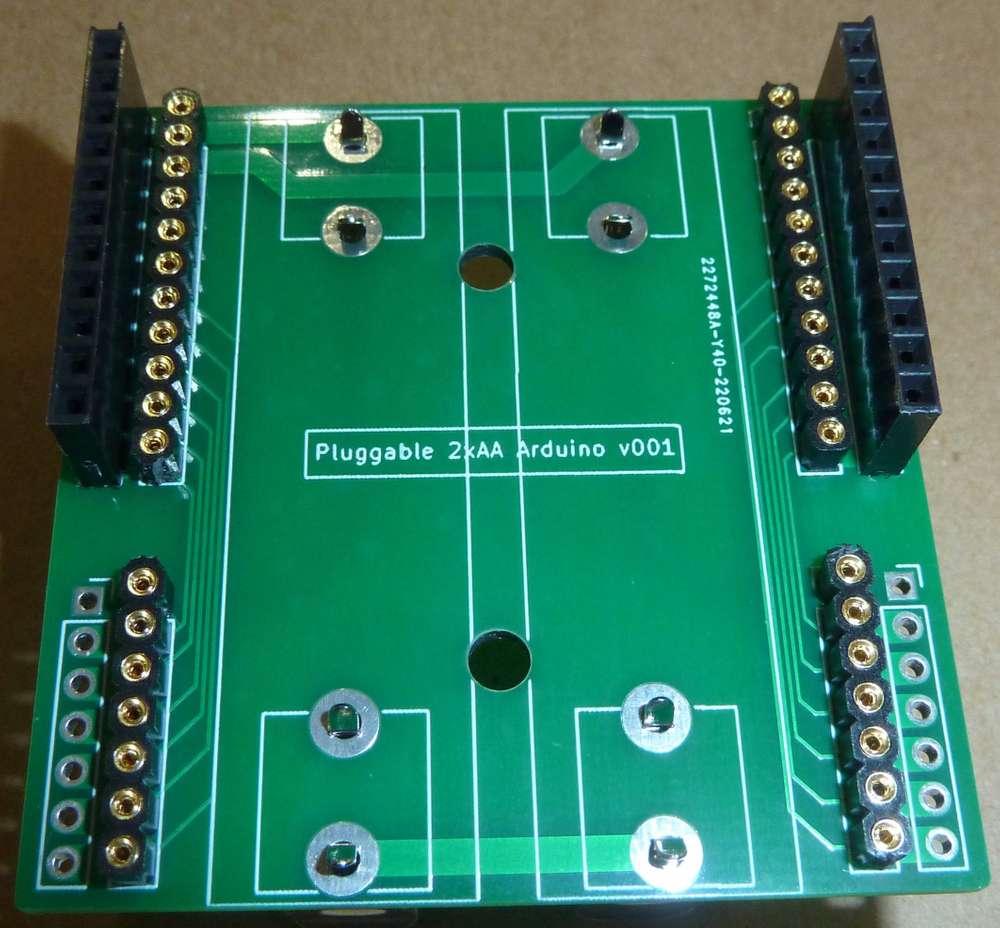
The good news:
-
I widened the separation between the batteries, and now the clips aren't at risk of shorting against one another.
-
list itemThe machine pins now sit nice and low against the PCB. The idea is that this way a shield can arch overhead without having to add much to the overall height. That's why I have regular headers on the outside part.
Not so great: as a guard against shorting against the clips, I maybe overcompensated by overwidening the headers as well. I think I can probably narrow the overall board width by 3 to 6mm and still have adequate clearance. I'll do some more iterations until I zero in.
Also, unlike the earlier test platform, this board lacks a way to separate out current measurement to the radio vs to the mcu. Since I already have the test platform for that, I don't think I care, but maybe someone else would want that? It could be added to the backplane, or it could be added to the plug-in modules themselves.
Lastly, I'm noticing that the battery clips fit so tightly against the PCB holes that you probably don't even need to solder them!

-
-
@NeverDie said in Most reliable "best" radio:
I widened the separation between the batteries, and now the clips aren't at risk of shorting against one another.
It's looking good! I'm curious, how far apart are the battery clips now (center-center)? I noted on the original board layout it was 15.62mm. I'm guessing it's about an extra 3mm based on the lines of the silkscreen and the size of the mounting holes you added.
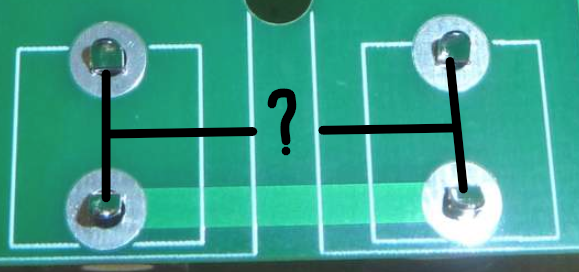
Also, an off-topic question for you - I believe I read in a thread somewhere recently (not sure which one though) that when adding a USB port you prefer USB Mini. Which footprint do you like to use and where do you source them from?
-
@alphaHotel said in Most reliable "best" radio:
It's looking good! I'm curious, how far apart are the battery clips now (center-center)?
Most likely it will be either 16.75mm or 17.75mm. 17.75mm is plenty wide. I have some test boards coming at 16.75mm to see if losing 1mm still guarantees adequate separation.
As for which USB connector, it depends on context. If size is not an issue, then lately I'm liking USB-B more than USB-mini. It's the same USB connector commonly found on the classic Arduino Uno. Super robust. I recently sourced 10 of them from mouser: https://www.mouser.com/ProductDetail/490-UJ2-BH-2-TH at close to 50 cents each.
-
@NeverDie, Thank you.